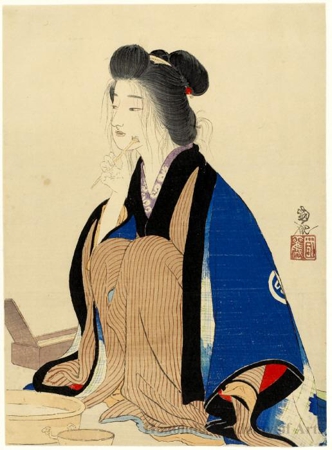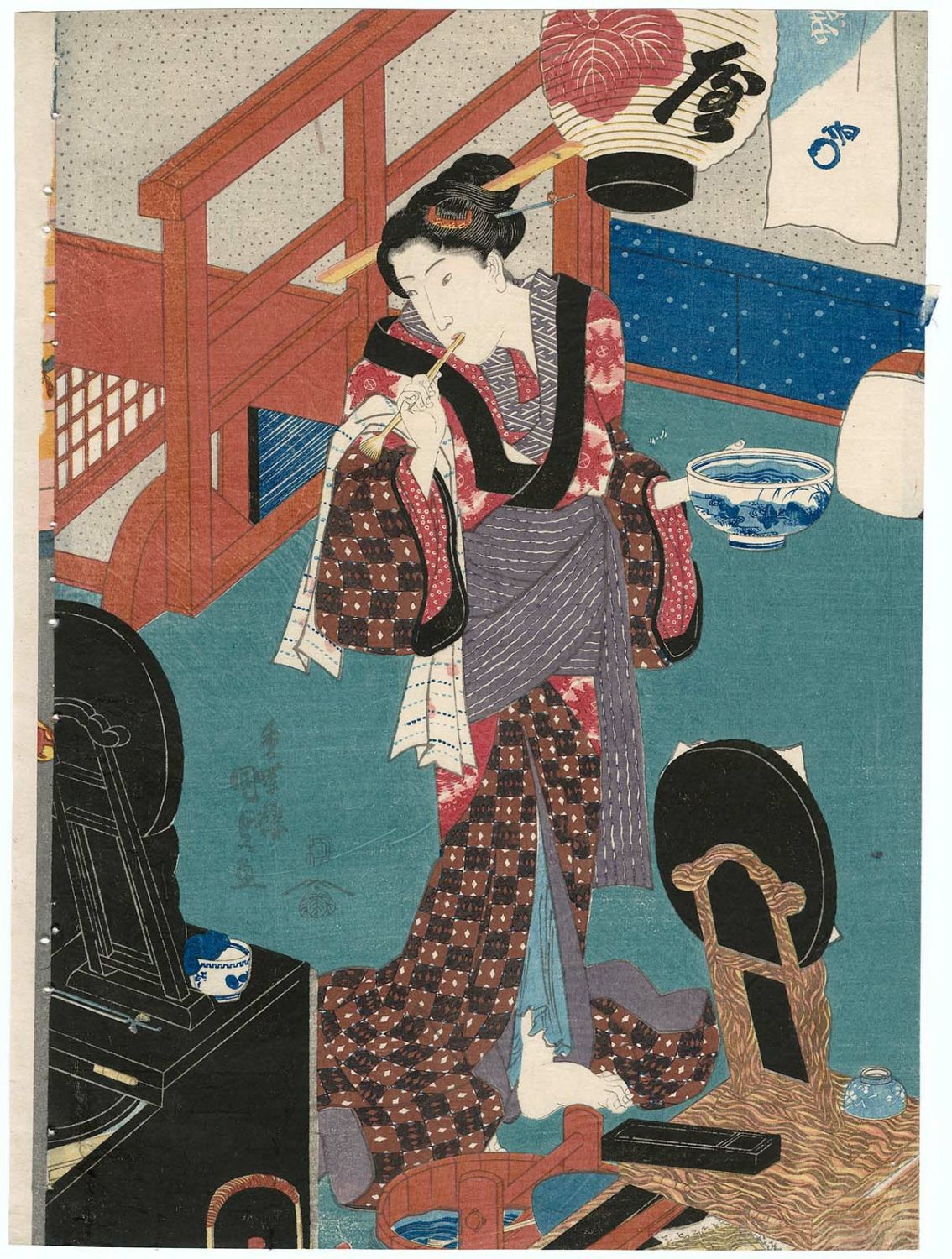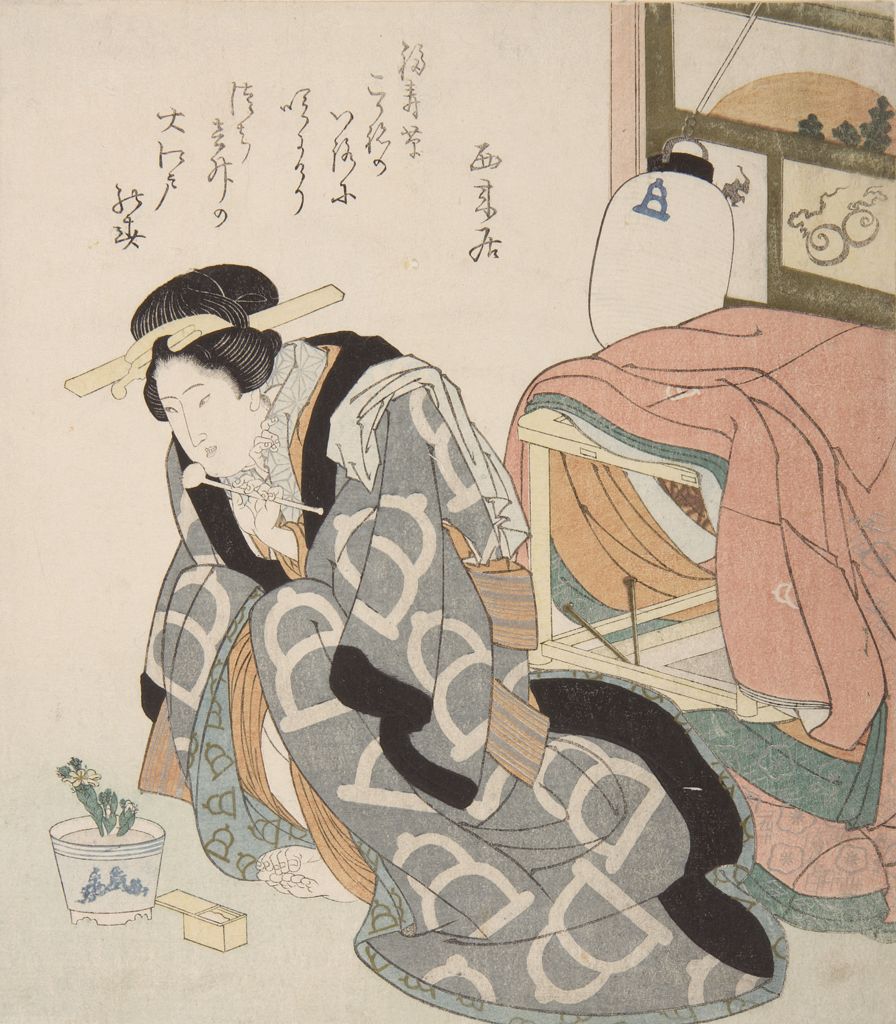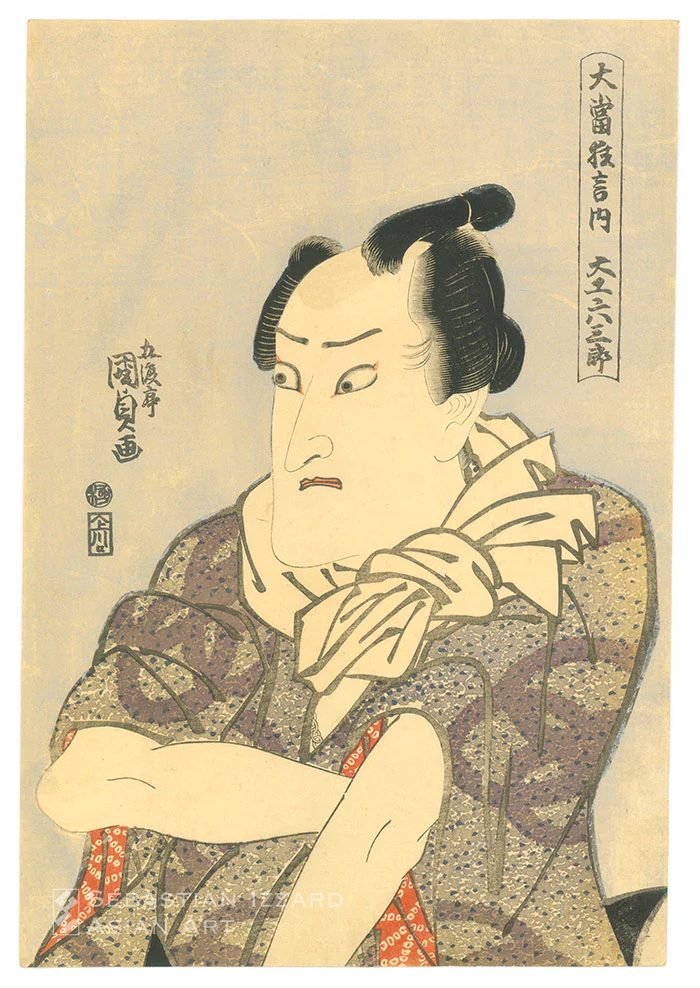-
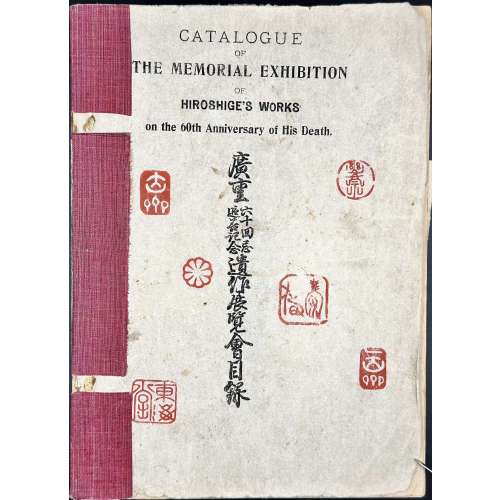 NEWPaperback volume with quarter red cloth backing 257 x 185 mm, black lettering in English and Japanese to front, red seals fac-simile to front and back; pp. [6] 1-6, 2-6 plates verso only, 7-26 [4] 1-66 [2] 7-88 plates verso only [2], some plates in colour with captioned tissue guards, incl. frontispiece memorial portrait of Utagawa Hiroshige [歌川 広重] a.k.a. Andō Hiroshige [安藤 広重] (Japanese, 1797 – 1858). Limited edition of 275 copies, this is copy № 254. Title-page: CATALOGUE | OF | THE MEMORIAL EXHIBITION | OF | HIROSHIGE'S WORKS | on the 60th Anniversary of His Death. | {red diamond} | Compiled and Published | BY | S. WATANABE. | (Ukiyoye Association) | TOKYO. | 1918. || Author: Shōzaburō Watanabe [渡辺 庄三郎] (Japanese, 1885 – 1962) Five fan prints: № 173. REFLECTED MOON ON THE SUMIDA. № 174. TOTO SHINAGAWA NO KEI. Shinagawa Beach, Yedo. № 179. ZUSÕ HAKONEYAMA YAKO NO ZU. Night Ascent of Hakone Pass. Published by Dansendo. № 180. TSUKI NO SANKEI. Beauties in a boat enjoying evening cool at Ryōgoku, from Three Moonlight Scenes. Published by Dansendo. № 182. SUMIDAGAWA HASHIBA WATASHI VUKI NO KEI. A Ferry Boat at a Sumida River Landing in Snow.
NEWPaperback volume with quarter red cloth backing 257 x 185 mm, black lettering in English and Japanese to front, red seals fac-simile to front and back; pp. [6] 1-6, 2-6 plates verso only, 7-26 [4] 1-66 [2] 7-88 plates verso only [2], some plates in colour with captioned tissue guards, incl. frontispiece memorial portrait of Utagawa Hiroshige [歌川 広重] a.k.a. Andō Hiroshige [安藤 広重] (Japanese, 1797 – 1858). Limited edition of 275 copies, this is copy № 254. Title-page: CATALOGUE | OF | THE MEMORIAL EXHIBITION | OF | HIROSHIGE'S WORKS | on the 60th Anniversary of His Death. | {red diamond} | Compiled and Published | BY | S. WATANABE. | (Ukiyoye Association) | TOKYO. | 1918. || Author: Shōzaburō Watanabe [渡辺 庄三郎] (Japanese, 1885 – 1962) Five fan prints: № 173. REFLECTED MOON ON THE SUMIDA. № 174. TOTO SHINAGAWA NO KEI. Shinagawa Beach, Yedo. № 179. ZUSÕ HAKONEYAMA YAKO NO ZU. Night Ascent of Hakone Pass. Published by Dansendo. № 180. TSUKI NO SANKEI. Beauties in a boat enjoying evening cool at Ryōgoku, from Three Moonlight Scenes. Published by Dansendo. № 182. SUMIDAGAWA HASHIBA WATASHI VUKI NO KEI. A Ferry Boat at a Sumida River Landing in Snow. -
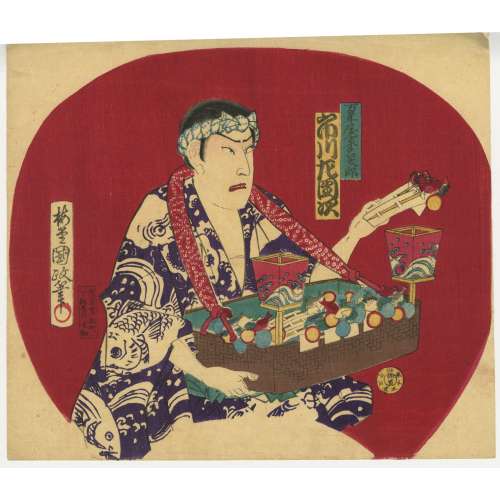 NEW
NEWTitle: Kabuki Actor Ichikawa Sadanji I as Mannenya Kamei Tarō
Artist: Utagawa Kunisada III (Baido Kunimasa) [Japanese, 1848–1920]
Signature: Baidō Kunimasa hitsu (梅堂國政筆)
Actor: Ichikawa Sadanji I (市川左団次, also known as Ichikawa Shōjaku I, Ichikawa Koyone, Ichikawa Tatsuzō) [Japanese, 1842–1904]
Role: Mannenya Kamei Tarō (万年屋家名太郎)
Play: Unidentified
Publisher: Shimōsaya Masukichi (下総屋升吉)
Publisher’s Address: Asakusa, Kurofune-chō (浅草 黒舩)
Date: [明治十三年三月] Meiji 13 (1880), 3rd month
Medium: Uchiwa-e (団扇絵, fan print), ink and colour on paper, 245 × 282 mmThis uchiwa-e (fan print) by Utagawa Kunisada III (also known as Utagawa Kunimasa IV) portrays the kabuki actor Ichikawa Sadanji I in the role of Mannenya Kamei Tarō. The figure is depicted in a dramatic stance, dressed in a striking blue kimono adorned with fish and wave motifs, suggesting a maritime or festival connection. He carries a large basket supported by a fabric strap around his neck, filled with small toy fish attached to sticks, along with round objects that could be festival sweets or miniature decorations. He holds one of these toy fish-on-a-stick items in his right hand, possibly demonstrating it as part of a vendor's performance.
The background is a bold, deep red, contrasting with the detailed rendering of the actor’s expression and costume. The print was published in 1897 (Meiji 30) by Shimōsaya Masukichi, a publisher based in Asakusa, Kurofune-chō. Though the exact play remains unidentified, the composition captures a moment from a kabuki performance where street vendors and festival sellers were often featured as comic or supporting characters in Edo-period narratives.
This work exemplifies the continuation of traditional kabuki actor portraiture into the Meiji period, reflecting both theatrical culture and popular printmaking traditions at the time.
-
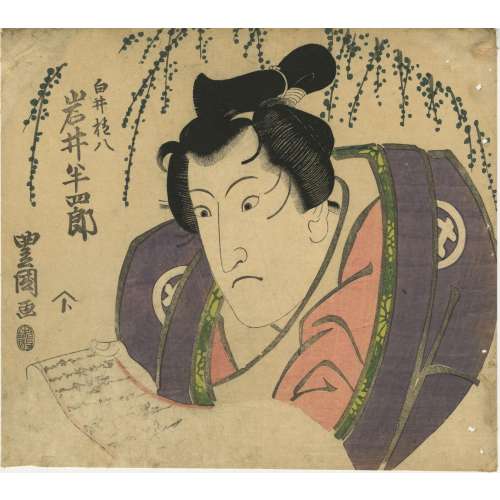 NEWKabuki actor Iwai Hanshiro V, in the role of Shirai Gonpachi, stands under a willow tree (yanagi, 柳) to read a letter from the courtesan Komurasaki of the Miuraya [三浦屋小紫]. In this letter, Komurasaki laments their unfortunate love. This is a scene from the kabuki play The Floating World's Pattern and Matching Lightning Bolts (Ukiyozuka hiyoku no inazuma) [浮世柄比翼稲妻] written by Tsurya Namboku IV [鶴屋南北]; it was played for the first time in March 1823 at Ichimura Theatre [市村座] in Edo. This play was later divided into two individual pieces: Saya-ate [鞘当] and Fuwa [不破]. On the shoulders of the actor's garment is a character 井 in a circle — both names, Iwai 岩井 and Shirai 白井, use this character.
NEWKabuki actor Iwai Hanshiro V, in the role of Shirai Gonpachi, stands under a willow tree (yanagi, 柳) to read a letter from the courtesan Komurasaki of the Miuraya [三浦屋小紫]. In this letter, Komurasaki laments their unfortunate love. This is a scene from the kabuki play The Floating World's Pattern and Matching Lightning Bolts (Ukiyozuka hiyoku no inazuma) [浮世柄比翼稲妻] written by Tsurya Namboku IV [鶴屋南北]; it was played for the first time in March 1823 at Ichimura Theatre [市村座] in Edo. This play was later divided into two individual pieces: Saya-ate [鞘当] and Fuwa [不破]. On the shoulders of the actor's garment is a character 井 in a circle — both names, Iwai 岩井 and Shirai 白井, use this character.
More information about the play and the real story behind it can be found at Lyon Collection. Actor: Iwai Hanshirō V [岩井半四郎] (Japanese, 1776 – 1847); other names: Iwai Tojaku, Iwai Kumesaburō I. Role: Shirai Gonpachi [白井権八] Artist: Utagawa Toyokuni I [歌川豊国] (1769–1825). Signed: Toyokuni ga [豊国画]. Publisher: Enshūya Matabei [遠州屋又兵衛] (Enterprise, active c. 1768 – 1881); seal: “to” (ト) under roof (Marks 01-031 | 057a). Date-aratame censor seal: 未改, Bunsei 6 (1823). Media: Aiban yoko-e uchiwa-e 団扇絵), 233 x 260 mm."Ukiyozuka Hiyoku no Inazuma" is a kabuki play in nine acts, written by Tsuruya Nanboku IV. It premiered in Bunsei 6 (1823) at the Ichimura-za theatre in Edo.
The play includes two particularly famous scenes:
- "Suzugamori no ba" (The Scene at Suzugamori), which portrays the episode of Banzuiin Chōbei and Shirai Gonpachi
- "Yoshiwara Nakanochō no ba" (The Scene at Yoshiwara Nakanochō), which depicts the story of Nagoya Sanza and Fuwa Banzaemon
These scenes have been frequently performed under the well-known titles "Gozonji Suzugamori" (A Well-Known Suzugamori) and "Sayaate" (The Scabbard Clash).
-
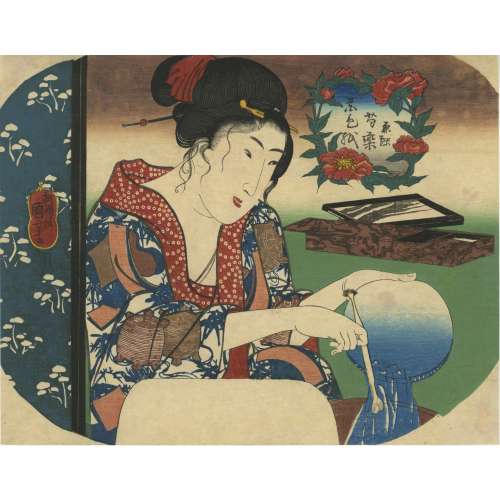 NEWPeonies (Shakuyaku) [芍薬] Series: Flower-Colored Papers (Hana Shikishi) [花色紙] Artist: Utagawa Kuniyoshi [歌川 國芳] (Japanese, 1798–1861) Signature: Chō-ō-rō Kuniyoshi ga (朝櫻楼 國芳 画) Publisher: Kojimaya Jūbei [小島屋 十兵衛] (Japanese, 1797 – 1869); seal 十, Marks 06-014 | 264a Date/Censorship Approval: Nanushi seal Yoshimura (吉村) for Yoshimura Gentarō (吉村 源太郎), VI/1843–XI/1846. Medium: Rigid fan print (Aiban Yoko-e Uchiwa-e, 合判横絵 団扇絵), 222 x 284 mm.
NEWPeonies (Shakuyaku) [芍薬] Series: Flower-Colored Papers (Hana Shikishi) [花色紙] Artist: Utagawa Kuniyoshi [歌川 國芳] (Japanese, 1798–1861) Signature: Chō-ō-rō Kuniyoshi ga (朝櫻楼 國芳 画) Publisher: Kojimaya Jūbei [小島屋 十兵衛] (Japanese, 1797 – 1869); seal 十, Marks 06-014 | 264a Date/Censorship Approval: Nanushi seal Yoshimura (吉村) for Yoshimura Gentarō (吉村 源太郎), VI/1843–XI/1846. Medium: Rigid fan print (Aiban Yoko-e Uchiwa-e, 合判横絵 団扇絵), 222 x 284 mm.Interpretation of the Inscription in the Floral Cartouche
- 花色紙 (Hana Shikishi) – "Flower-Colored Paper" or "Decorative Shikishi Paper with Floral Motifs"
- 芍薬 (Shakuyaku) – "Peony", a flower symbolizing prosperity, beauty, and romance in Japanese culture
- 団扇絵 (Uchiwa-e) – "Round Fan Illustration" or "Picture on an Uchiwa (rigid fan)"
Description & Symbolic Analysis
This print, part of the Hana Shikishi (Flower-Colored Papers) series, depicts a woman washing a basin after brushing her teeth. She is positioned behind an indigo-colored folding screen, adorned with a repeating pattern of distant pines, presented in reverse printing technique (wyabori, 捺ぼり). The screen is a visual separator, adding depth and an intimate atmosphere to the scene. The woman is portrayed in a three-quarter view, facing left, her face delicately contoured. She is dressed in a safflower-dyed kimono (furisode, 振袖) featuring an asanoha (麻の葉, hemp leaf) shibori pattern, a motif often associated with purity and protection. Over this, she wears an outer garment decorated with an indigo bamboo motif, symbolizing strength and resilience. Additionally, the garment features:- Double gourd (瓢箪, hyōtan) symbolises longevity, fertility, and good fortune.
- Strips of paper resembling “next-morning letters” (kinuginu no fumi, 衣衣の文) – These evoke romantic correspondence or the written wishes of the Tanabata festival.
- Spools or reels of thread (chikiri, 糸巻き) – A motif reminiscent of Tanabata festival themes, often linked to the celestial lovers Orihime and Hikoboshi. The phonetic pun with chigiri (契り, vow or romantic promise) reinforces themes of marriage, fate, and lifelong bonds.
Adornment & Hairstyling
Her elaborate hairstyle features a red hair tie (musubi, 結び), signifying youth and romantic allure. It is further adorned with:- Golden kogai (笄) – A decorative hairpin, often used by courtesans or high-ranking women.
- Tama kanzashi (玉簪) – A ball-tipped ornamental hairpin, reinforcing her refined status.
Objects in the Scene & Their Symbolism
The woman is holding a traditional Japanese toothbrush (fusa-yōji, ふさ楊枝) in her right hand, while pouring out water from the basin after brushing her teeth. This act symbolizes purity and preparation for intimacy. To her right, an ornate lacquered writing box (suzuribako, 硯箱) is placed near an inkstone (硯, suzuri). This object could also be interpreted as a dreamstone (梦石, mèng shí), a scholar’s object associated with nostalgia, love, or secret communication.Context in Ukiyo-e Tradition
Tooth brushing was uncommon in bijin-ga (美人画, "beautiful woman prints"). Ukiyo-e frequently depicted women engaging in personal grooming rituals, reflecting ideals of elegance and self-care in Edo-period culture.
Two additional fan prints from the Hana Shikishi series have been identified and can be found at the Kuniyoshi Project website:- Morning Glory (Asagao, 朝顔)
- Clematis (Tessen, 鉄線)
These prints, like Peonies (Shakuyaku), emphasize seasonal beauty and feminine refinement, themes central to Kuniyoshi’s bijin-ga oeuvre.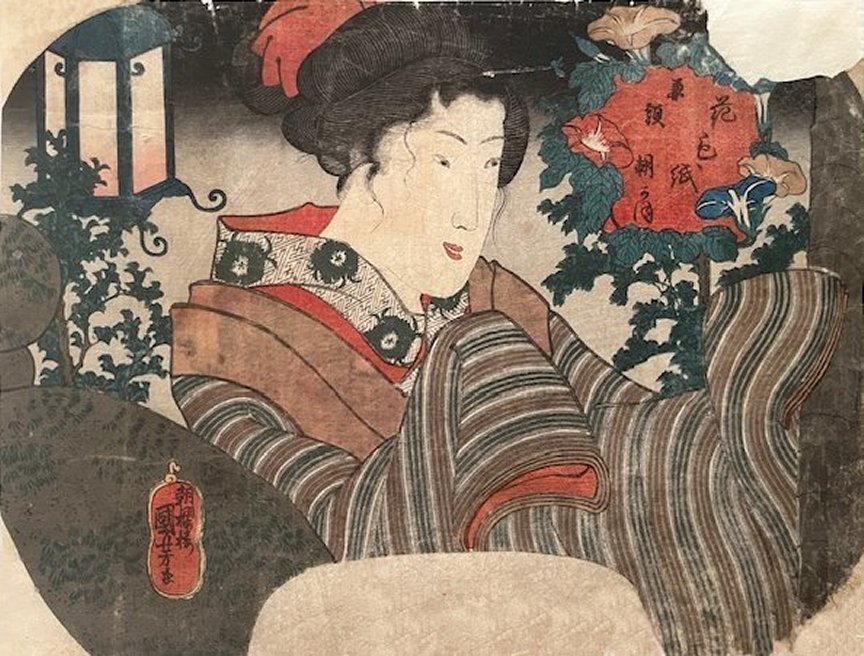
Morning Glory (Asagao, 朝顔)
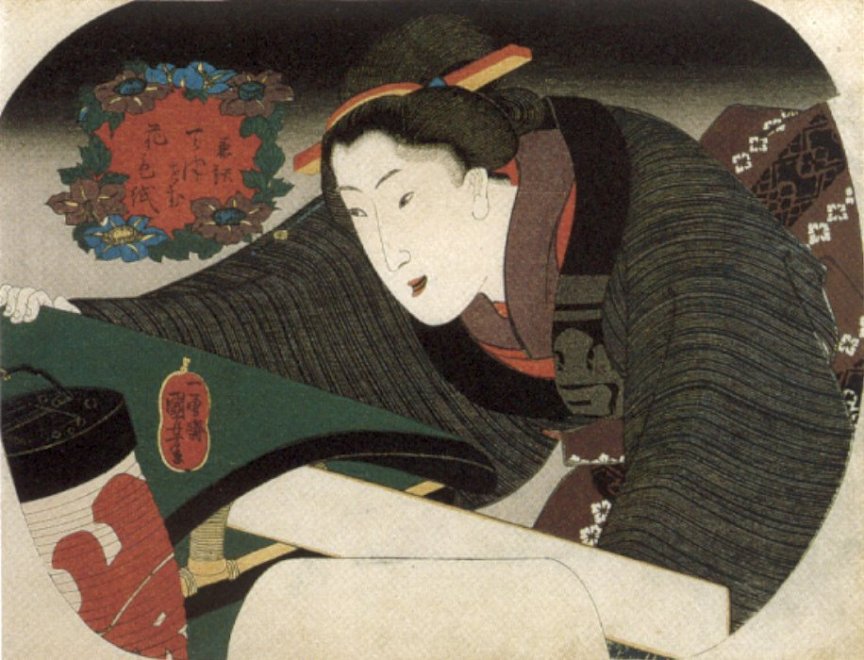
Clematis (Tessen, 鉄線)
-
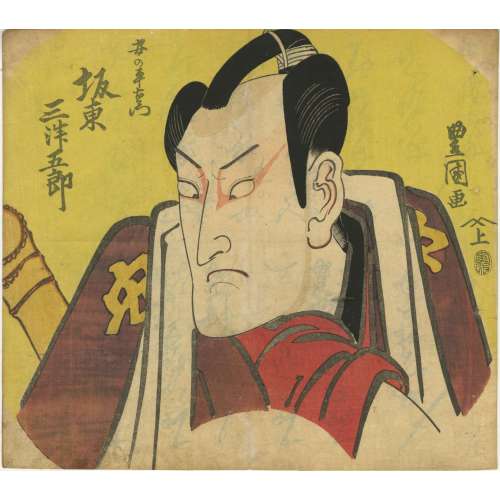 NEW
NEWArtist: Utagawa Toyokuni I [初代豊国] (Japanese, 1769–1825)
Publisher: Iseya Sōemon [伊勢屋惣右衛門] (c. 1776 – November 1862); Marks 02-041 | 156a
Date-Aratame Seal: Bunsei 1 (文政元年, 1818)
Media: Print (Yakusha-e, 役者絵); 223 x 250 mm
Actor: Bandō Mitsugorō III [三代目 坂東 三津五郎] (Japanese, 1775–1831); also known as Bandō Minosuke I, Morita Kanjirō II, Bandō Mitahachi I, Bandō Minosuke I, Bandō Mitahachi I.
Role: Anno Heiemon [安の平右衛門], also known as Anno Heibei [安の平兵衛].
Play: Shiire Zome Karigane Gomon [仕入染雁金五紋] (しいれぞめかりがねごもん), staged in May 1818 at Nakamuraza Theatre in Edo (modern-day Tokyo).
Bust-length, three-quarter-view portrait of actor Bandō Mitsugorō III as Anno Heibei, one of the gonin otoko [五人男]—a group of five chivalrous thieves. The actor is dressed in a red and purple robe, with a golden mon (family crest) on the shoulders, displaying the character 安 (An), which, in this case, represents the first ideogram in the name of his role. A shakuhachi (尺八), a traditional Japanese end-blown bamboo flute, is secured on his back.
-
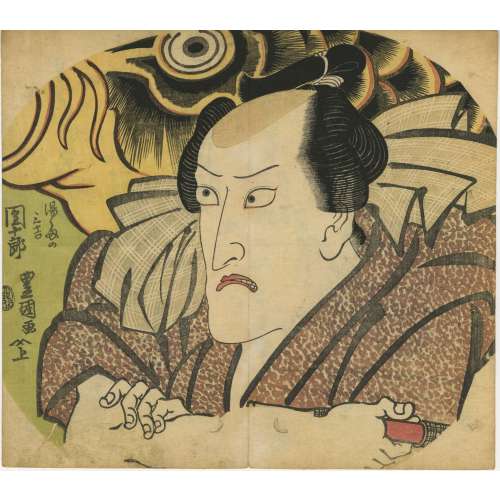 NEWArtist: Utagawa Toyokuni I [初代豊国] (Japanese, 1769–1825) Signed: Toyokuni ga [豊国画]. Publisher: Iseya Sōemon [伊勢屋惣右衛門] (c. 1776 – November 1862); Marks 02-041 | 156a Date-Aratame Seal: 1819 (Bunsei 2, 文政二年) Media: Print (Yakusha-e, 役者絵); 221 x 253 mm
NEWArtist: Utagawa Toyokuni I [初代豊国] (Japanese, 1769–1825) Signed: Toyokuni ga [豊国画]. Publisher: Iseya Sōemon [伊勢屋惣右衛門] (c. 1776 – November 1862); Marks 02-041 | 156a Date-Aratame Seal: 1819 (Bunsei 2, 文政二年) Media: Print (Yakusha-e, 役者絵); 221 x 253 mmActor: Ichikawa Danjūrō VII [七代目市川團十郎] (Japanese, 1791–1859); Other names: Ichikawa Ebizō V (五代目市川海老蔵), Ichikawa Hakuen II (二代目市川白猿), Ichikawa Shinnosuke I (初代市川新之助).
Role: Yushima no Sankichi (ゆしまの三吉) Play: Ume Yanagi Wakaba no Kagazome (梅柳若葉加賀染) Theater: Tamagawa-za (玉川座), Edo, May 1819 Bust-length, three-quarter-view portrait of Ichikawa Danjūrō VII as Yushima no Sankichi, in the play Ume Yanagi Wakaba no Kagazome, staged at Tamagawa-za in May 1819. The actor is depicted with his arms crossed over his chest, holding a pipe (kiseru, 煙管) in his right hand. The upper half of the background features a giant golden carp (鯉, koi), symbolizing Boys' Day (Tango no Sekku) (端午の節句), celebrated on May 5th each year. This print forms a pair with the portrait of Kabuki actor Segawa Kikunojō V as Kurenaiya Okan [SVJP-0440.2025], but no conclusive information is available regarding the relationship between their characters.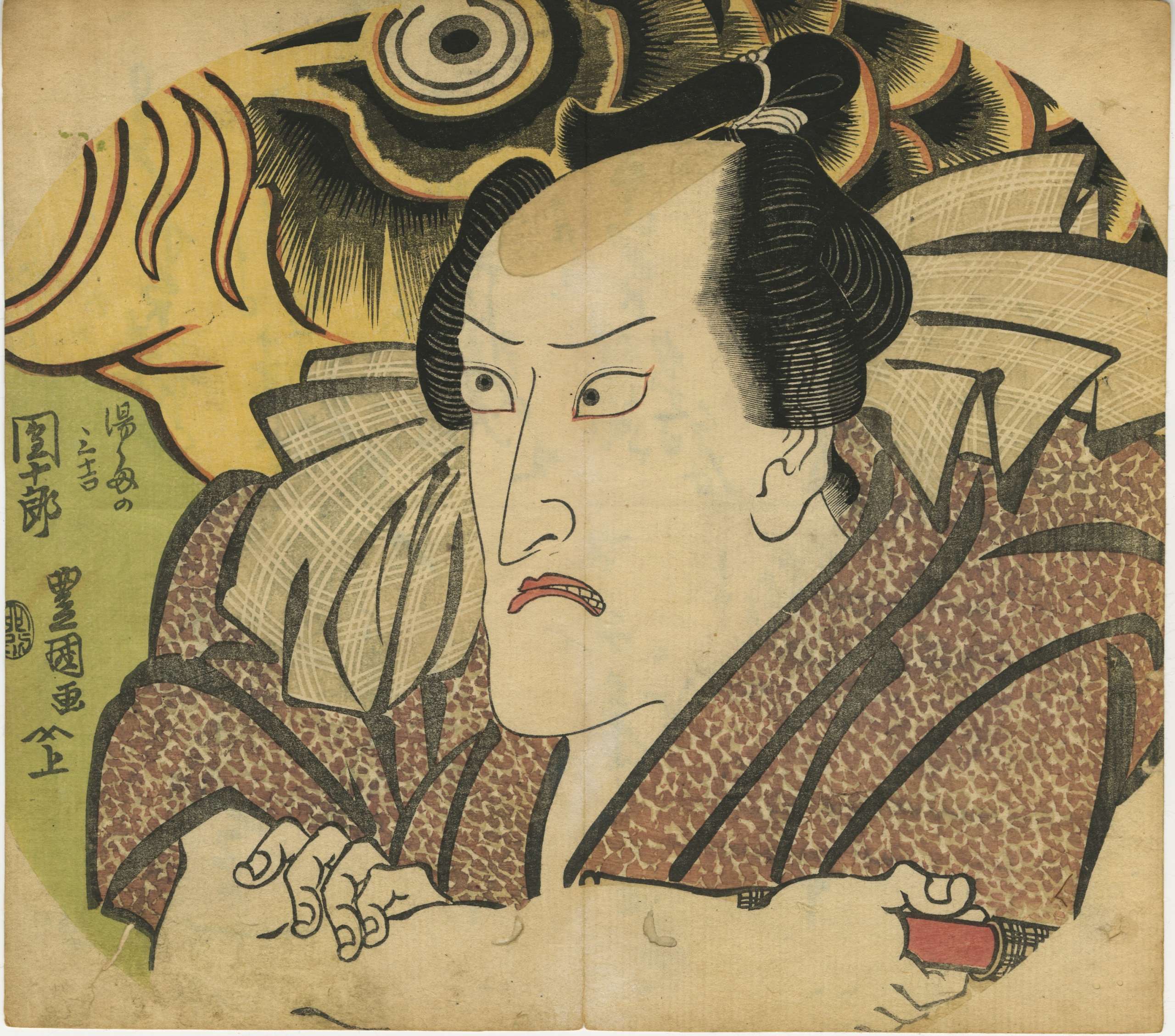
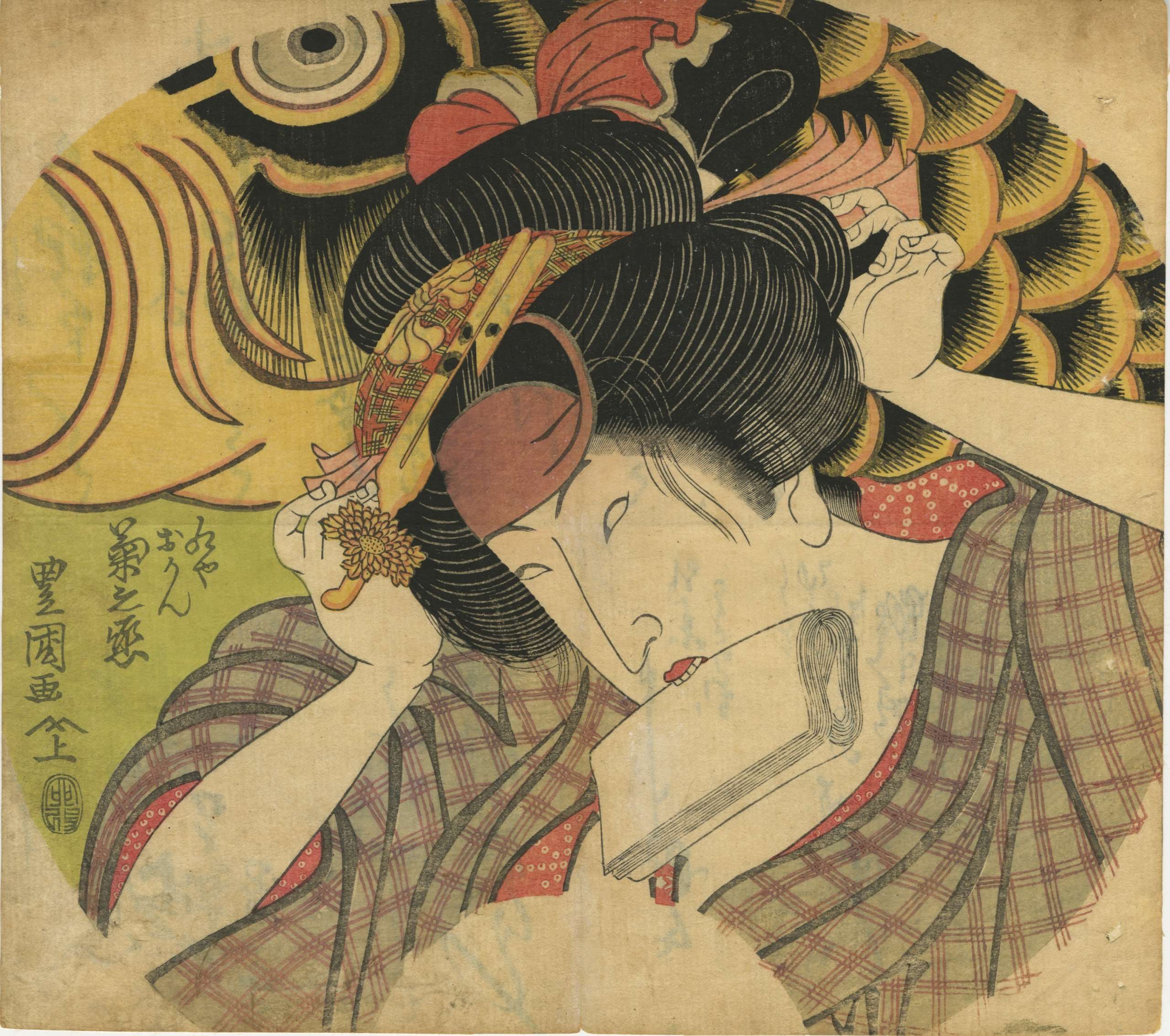
-
 NEWArtist: Utagawa Toyokuni I [初代豊国] (Japanese, 1769–1825) Signed: Toyokuni ga [豊国画]. Publisher: Iseya Sōemon [伊勢屋惣右衛門] (c. 1776 – November 1862); Marks 02-041 | 156a Date-Aratame Seal: 1819 (Bunsei 2, 文政二年) Media: Print (Yakusha-e, 役者絵); 221 × 253 mm Play: Ume Yanagi Wakaba no Kagazome (梅柳若葉加賀染) Theater: Tamagawa-za (玉川座), Edo, May 1819 Role: Kurenaiya Okan (紅屋おかん) Actor: Segawa Kikunojō V [瀬川菊之丞] (Japanese, 1802–1832); Other name: Segawa Tamon I (瀬川多聞初代) Bust-length, three-quarter-view portrait of Segawa Kikunojō V as Kurenaiya Okan in the play Ume Yanagi Wakaba no Kagazome, staged at Tamagawa-za in May 1819. The male actor Segawa Kikunojō V performs an onnagata role, portraying a courtesan. She is depicted adjusting her elaborate shimadamage-style coiffure, fixing a kanzashi (簪, hairpin) while holding onkotogami (御懲紙, tissue paper) in her mouth. The onkotogami was traditionally used for intimate hygiene, suggesting that the scene represents a moment after encountering a client. Her inner kimono is safflower-dyed and has a hemp leaf pattern (麻の葉, asa no ha). The top half of the background features a giant golden carp (鯉, koi), a recurring motif in this pair of prints often associated with strength, perseverance, and kabuki’s aragoto style. This print forms a pair with the portrait of Ichikawa Danjūrō VII as Yushima no Sankichi [SVJP-0439.2025], but no conclusive information is available regarding the relationship between their characters. The carp also alludes to Boys' Day (Tango no Sekku, 端午の節句), celebrated on May 5th each year.
NEWArtist: Utagawa Toyokuni I [初代豊国] (Japanese, 1769–1825) Signed: Toyokuni ga [豊国画]. Publisher: Iseya Sōemon [伊勢屋惣右衛門] (c. 1776 – November 1862); Marks 02-041 | 156a Date-Aratame Seal: 1819 (Bunsei 2, 文政二年) Media: Print (Yakusha-e, 役者絵); 221 × 253 mm Play: Ume Yanagi Wakaba no Kagazome (梅柳若葉加賀染) Theater: Tamagawa-za (玉川座), Edo, May 1819 Role: Kurenaiya Okan (紅屋おかん) Actor: Segawa Kikunojō V [瀬川菊之丞] (Japanese, 1802–1832); Other name: Segawa Tamon I (瀬川多聞初代) Bust-length, three-quarter-view portrait of Segawa Kikunojō V as Kurenaiya Okan in the play Ume Yanagi Wakaba no Kagazome, staged at Tamagawa-za in May 1819. The male actor Segawa Kikunojō V performs an onnagata role, portraying a courtesan. She is depicted adjusting her elaborate shimadamage-style coiffure, fixing a kanzashi (簪, hairpin) while holding onkotogami (御懲紙, tissue paper) in her mouth. The onkotogami was traditionally used for intimate hygiene, suggesting that the scene represents a moment after encountering a client. Her inner kimono is safflower-dyed and has a hemp leaf pattern (麻の葉, asa no ha). The top half of the background features a giant golden carp (鯉, koi), a recurring motif in this pair of prints often associated with strength, perseverance, and kabuki’s aragoto style. This print forms a pair with the portrait of Ichikawa Danjūrō VII as Yushima no Sankichi [SVJP-0439.2025], but no conclusive information is available regarding the relationship between their characters. The carp also alludes to Boys' Day (Tango no Sekku, 端午の節句), celebrated on May 5th each year.

-
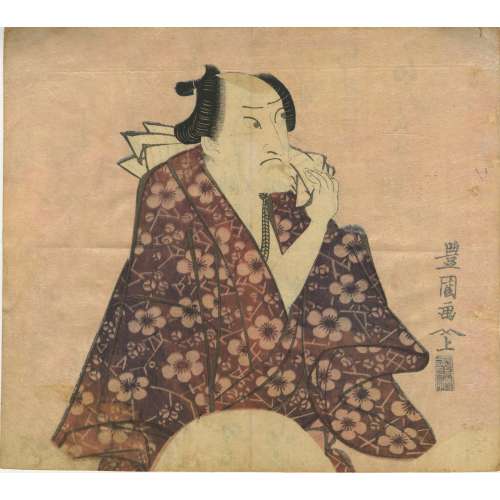 NEWArtist: Utagawa Toyokuni I [初代豊国] (Japanese, 1769–1825) Signed: Toyokuni ga [豊国画] Publisher: Iseya Sōemon [伊勢屋惣右衛門] (c. 1776 – November 1862); Marks 02-041 | 156a Gyōji Aratame Censor Seal: 行事改, 1810-18151 Media: Print (Uchiwa-e, うちわ絵, fan print), kira-zuri (きら摺り, mica printing); 222 × 250 mm
NEWArtist: Utagawa Toyokuni I [初代豊国] (Japanese, 1769–1825) Signed: Toyokuni ga [豊国画] Publisher: Iseya Sōemon [伊勢屋惣右衛門] (c. 1776 – November 1862); Marks 02-041 | 156a Gyōji Aratame Censor Seal: 行事改, 1810-18151 Media: Print (Uchiwa-e, うちわ絵, fan print), kira-zuri (きら摺り, mica printing); 222 × 250 mmActor: Onoe Baikō III [三代目尾上梅幸] (Japanese, 1784–1849); Other names: Onoe Kikugorō III (尾上菊五郎), Ōkawa Hashizō I (大川橋蔵初代), Onoe Matsusuke II (二代目尾上松助), Onoe Eizaburō I (初代尾上栄三郎)
Role: Konjin Chōgorō (金神長五郎) Play: Ku Kyōdai Shōbu Katabira (句兄弟菖蒲帷子) Theater: Nakamura-za (中村座), Edo, 1815 Half-length, three-quarter-view, facing to the left portrait of Onoe Baikō III as Konjin Chōgorō, in the play Ku Kyōdai Shōbu Katabira, staged at Nakamura-za in 1815. The actor wears a purple kimono with a plum blossom motif (梅, ume).A print from the Waseda University Tsubouchi Memorial Theatre Museum also depicts Onoe Baikō III as Konjin Chōgorō, showing him holding a box inscribed with 神金 (Kane no Kami). The name Konjin consists of the same kanji in reverse order – reading right to left (金神).
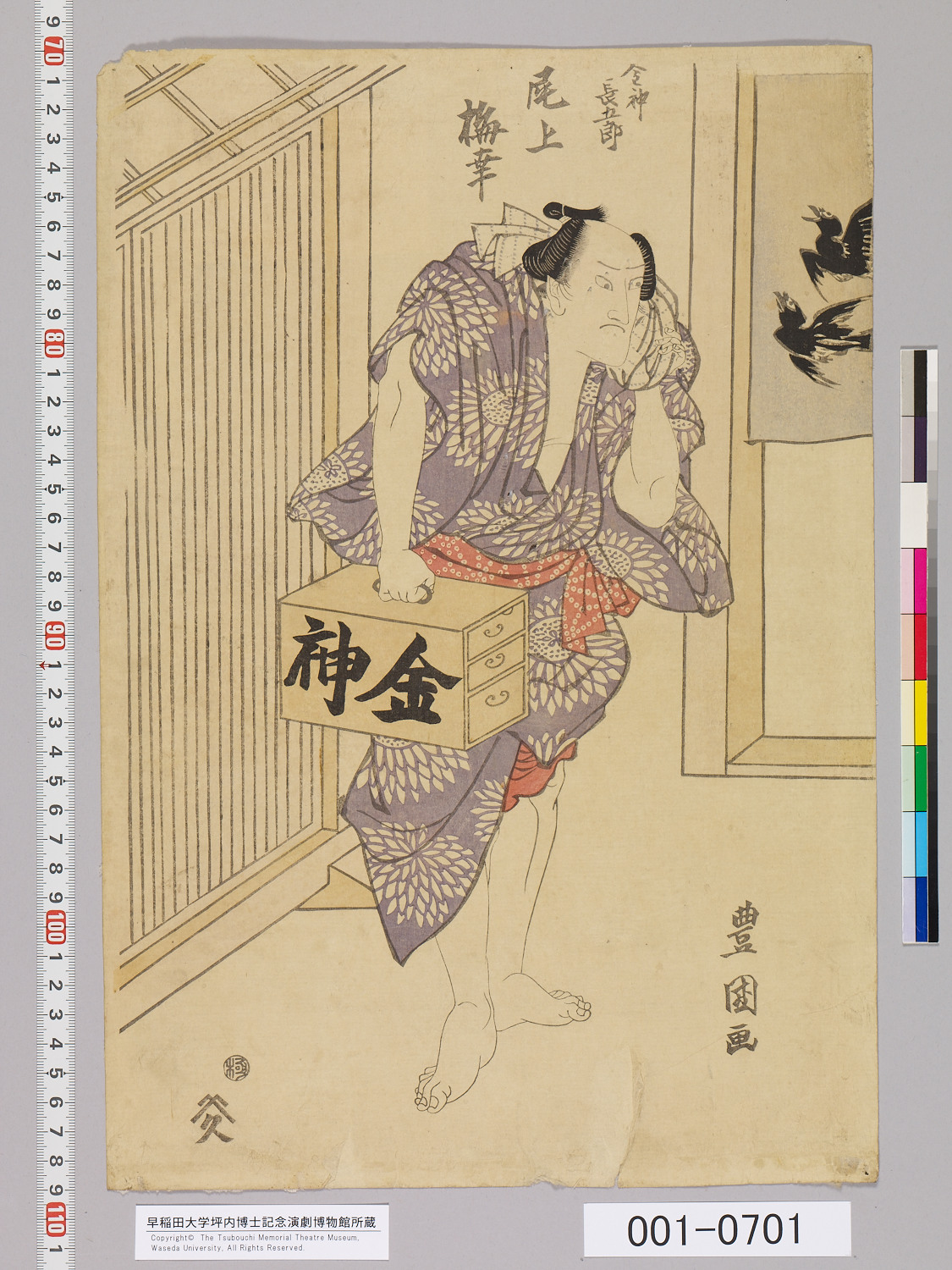
Konjin Chōgorō is a legendary figure in Japanese folklore, renowned as a formidable sumo wrestler. His tales often depict him engaging in supernatural feats, such as vanquishing demons and showcasing extraordinary strength.
In the realm of kabuki theatre, Konjin Chōgorō's character has been portrayed in various plays, though specific details about Ku Kyōdai Shōbu Katabira (句兄弟菖蒲帷子) remain unknown.
Notes
-
A certain confusion regarding the attribution of this print arises from the statement by Andreas Marks (Publishers, 2011, p. 488), which asserts that the gyōji aratame seal was used exclusively for fan prints between 1810 and 1814. However, it is known that Onoe Baikō III performed the role of Konjin Chōgorō at Nakamura-za in the 5th month of 1815. Marks also notes that the earliest known fan print bearing this seal dates to 1810; based on this new evidence, we may now consider the latest known instance to be the 5th month of 1815.
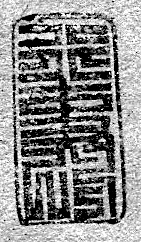
-
-
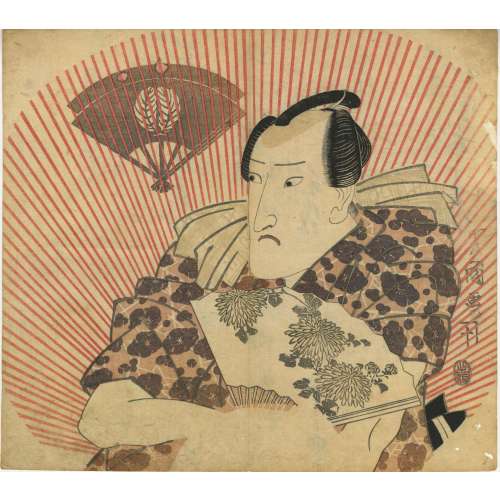 NEW
NEWArtist: Utagawa Toyokuni I [初代豊国] (Japanese, 1769–1825)
Signed: Toyokuni ga [豊国画]
Publisher: Kojimaya Jūbei [小嶋屋重兵衛] (Japanese, c. 1797–1869); seal [十]; Marks 06-014 | 264a
Date-Aratame Seal: 1822 (Bunsei 5, 文政五年)
Media: Print (Uchiwa-e, うちわ絵, fan print); 223 × 250 mm
Actor: Onoe Kikugorō III [三代目 尾上菊五郎] (Japanese, 1784–1849); other names: Onoe Baikō III (尾上梅幸), Ōkawa Hashizō I (大川橋蔵初代), Onoe Matsusuke II (二代目尾上松助), Onoe Eizaburō I (初代尾上栄三郎)
Half-length, three-quarter-view portrait of Onoe Kikugorō III, depicted without stage makeup. The actor wears a kimono patterned with plum blossoms (梅, ume), symbolising perseverance and longevity. A neck scarf with a 格子 (kōshi) pattern is visible, and he holds a folding fan (扇, ōgi) decorated with chrysanthemums (菊, kiku).
Above his head is the Onoe family crest (mon), embracing oak leaves on layered fans. This emblem, known as the crest of the Otowaya line, commemorates a shogunal gift of rice cakes wrapped in oak leaves, placed on a fan, and presented to Onoe Kikugorō I.
The background features a radiating red-line pattern, possibly representing the bamboo structure of an uchiwa fan. The absence of kumadori (歌舞伎隈取, kabuki makeup) suggests that the actor is not portrayed in a specific role.
In 1822, Onoe Kikugorō III performed at Kawarazaki-za before month 11 and at Ichimura-za and Nakamura-za afterwards.
The print has been backed for preservation with a sheet of paper featuring calligraphy, likely contemporary to the print itself. The backing paper appears to have been repurposed, a common historical practice in the Edo period, where discarded documents or manuscripts were reused to reinforce delicate prints.
Kunisada portrayed the same actor in 1815 as Rokusaburō, the Carpenter (Daiku Rokusaburō).
-
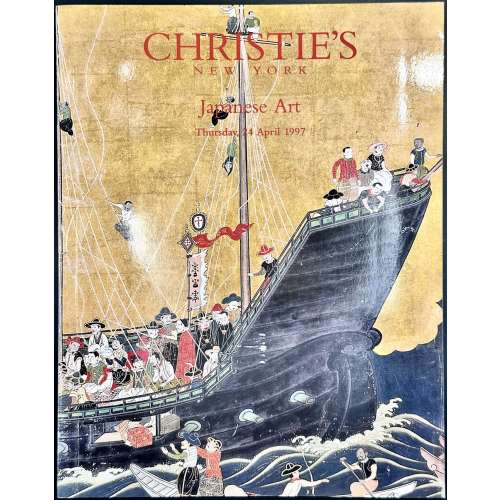 NEWSoftcover auction catalogue, 267 x 209 mm, pictorial wrappers with red lettering to cover, black and white lettering to spine; pp. [2] 3-179 [1]; auction held at Christie’s New York on Thursday, 24 April 1997, featuring lots 60-340, with properties from Japan Society, Inc., N.Y., Mary Griggs Burke, a lady, a European private collection, and various sources; includes descriptions and images of Japanese paintings, prints, ceramics, lacquer, and other works of art.
NEWSoftcover auction catalogue, 267 x 209 mm, pictorial wrappers with red lettering to cover, black and white lettering to spine; pp. [2] 3-179 [1]; auction held at Christie’s New York on Thursday, 24 April 1997, featuring lots 60-340, with properties from Japan Society, Inc., N.Y., Mary Griggs Burke, a lady, a European private collection, and various sources; includes descriptions and images of Japanese paintings, prints, ceramics, lacquer, and other works of art.Title-page: JAPANESE ART | Properties from | JAPAN SOCIETY, INC., N.Y. | MARY GRIGGS BURKE | A LADY | A EUROPEAN PRIVATE COLLECTION | AND FROM VARIOUS SOURCES | Auction | Thursday, 24 April 1997 at 11.00 a.m. approx. (Lots 60-194) | and at 2.00 p.m. (Lots 195-340) | 502 Park Avenue at 59th Street | New York, New York 10022 | Sale Code | In sending written bids or making inquiries, this sale should be referred to as #8670 | Viewing | […] |Christie's | 502 Park Avenue at 59th Street | New York, New York 10022 | Telephone: (212) 546 1000 | Internet: | http://www.christies.com | (40) Registered at the above address No. 1128160 | {CHRISTIE'S device} ||
Sixteen Fan Prints in this catalogue. 248. KUNIYOSHI: aiban uchiwa-e (22.5 × 29.4 cm.); entitled Hana no nishiki "Flower brocade", a half-length portrait of a beauty on a peony-decorated ground", signed Kuniyoshi ga and dated 4/1855—very good impression and color, some minute worm holes, binding holes on right. — Estimate: $2,500–3,500. 280. HIROSHIGE: aiban yoko-e, uchiwa-e (21.8 x 28.4 cm.); Tokaido, zuso Hakone sanchō kosui no zu “View of the lake in mountains at Hakone on the Tokaido between Izu and Sagami province”, and subtitled Bōsetsu “Evening snow”, from the series Omote ura chiji hakkei “Eight views of stations of the Tokaido and Kiso-kaidō”, signed Hiroshige ga—very good impression and color, faint vertical center fold restored on reverse, slightly soiled near corners. PROVENANCE: Theodor Scheiwe, sold in these Rooms, March 21, 1989, lot 264. PUBLISHED: Rose Hempel, Ausstellung Japanische Holzschnitte (Munster, 1959), no. 244, p. 145; Rose Hempel, Kunst Aus Japan (Essen: Villa Hügel, 1972), no. 496, p. 273; For another impression see Suzuki Juzo, Hiroshige (Tokyo: Nihon keizai shimbun, 1970), pl. 46. — Estimate: $10,000-15,000. 281. HIROSHIGE: aiban uchiwa-e (22.2 x 28.1 cm.); Yotsuya Shinjuku tsutsumi no hana “Cherry blossoms on the bank at Shinjuku, Yotsuya”, three women on a terrace overlooking cherry blossoms on the opposite bank in the night, signed Hiroshige ga, dated 1856, second month, and published by Ibaya Senzaburo—very good impression, color and condition. —Estimate: $8,000-10,000. 282. HIROSHIGE: aiban uchiwa-e (21.9 × 29.2 cm.); Sugita no baien "Plum garden at Sugita", signed Hiroshige ga and published by Sanoya Kihei—very good impression and color, binding holes on right restored, a minute repair on lower left. — Estimate: $8,000-10,000. 283. HIROSHIGE: aiban uchiwa-e (22.2 × 29.7 cm.); Buya Tsukuda no isaribune "Fishing boats at Tsukudajima in Musashi province", from the series Shokoku meisho "Famous places in the various provinces", signed Hiroshige ga over the publisher’s seal, published by Dansendō [Ibaya Senzaburō]—very good impression and color, faint center fold reinforced on the reverse, margins slightly soiled. PROVENANCE: Alexis Rouart, sold American Art Association, New York, February 6, 1922, lot 210; This impression was sold in these Rooms, December 4, 1984, lot 212. — Estimate: $10,000-15,000. 284. HIROSHIGE: aiban uchiwa-e (22.6 × 29 cm.); a tree and branches of yaezakura (double cherry blossoms) on a yellow background, signed Hiroshige hitsu and published by Dansendō [Ibaya Senzaburō]—very good impression and color, slightly stained, restoration on right. EXHIBITED: Pratt Graphics Center, New York, "Hiroshige: An exhibition of selected prints and illustrated books" (February 26—March 19, 1983); PUBLISHED: Sebastian Izzard, Hiroshige: An exhibition of selected prints and illustrated books (New York: The Ukiyo-e Society of America, 1983), no. 77. — Estimate: $6,000-8,000 285. HIROSHIGE: aiban uchiwa-e (23.2 × 29.4 cm.); Rokugo no watashi "The ferry at Rokugō", from the series Meisho fūkei "Famous landscapes", signed Hiroshige ga—very good impression and color, a worm hole in lower left margin, pasted on paper on upper corners; EXHIBITED: Pratt Graphics Center, New York, "Hiroshige: An exhibition of selected prints and illustrated books" (February 29—March 19, 1983); PUBLISHED: Sebastian Izzard, Hiroshige: An exhibition of selected prints and illustrated books (New York: The Ukiyo-e Society of America, 1983), no. 60. — Estimate: $6,000-8,000. 286. HIROSHIGE: aiban uchiwa-e (21.9 × 29 cm.); Shinshu, Suwako yukihare "Clear weather after snow at Lake Suwa in Shinano province", from the series Fuji sanjūrokkei no uchi "The thirty-six views of Mount Fuji", signed Hiroshige ga, dated 1842, and published by Ibaya Kyubei—very good impression and color, margins slightly soiled, vertical center fold restored.. EXHIBITED: Pratt Graphics Center, New York, "Hiroshige: An exhibition of selected prints and illustrated books" (February 29—March 19, 1983). PUBLISHED: Sebastian Izzard, Hiroshige: An exhibition of selected prints and illustrated books (New York: The Ukiyo-e Society of America, 1983), no. 51. — Estimate: $5,000-7,000. 287. HIROSHIGE: aiban uchiwa-e (22.4 × 28.7 cm.); Kodai buto "Classical dance", signed Ryūsai and published by Maruya Seijiro—good impression and color, slightly foxed, some minor worm holes, slightly creased, mat stain along edges, pasted on paper on upper corners, minor tear on upper edge. — Estimate: $3,000-4,000. 288. HIROSHIGE: chūban uchiwa-e (24.6 × 18.6 cm.); Kai Kawaguchi kosui no zu "View of the lake at Kawaguchi in Kai province", signed Hiroshige hitsu—good impression and color, slightly soiled, faint vertical center fold, binding holes on right restored. — Estimate: $3,000-4,000. 289. HIROSHIGE: aiban uchiwa-e (22.8 × 28.2 cm.); Karasaki no hitotsu matsu "Single pine tree at Karasaki", from the series Omi hakkei "Eight views of Lake Biwa", signed Hiroshige ga, dated 1852, seventh month, and published by Enshuya Matabei—very good impression and color, minute stains in lower right, pin holes on upper corners, vertical center fold. — Estimate: $5,000-7,000. 290. HIROSHIGE: aiban uchiwa-e (23.4 × 30 cm.); three stems of peonies on a blue background, signed Hiroshige ga, dated 1857, second month, and published by Marukyudo—very good impression and color, holes on right restored, some minor worming restored, otherwise good condition. EXHIBITED: Pratt Graphics Center, New York, "Hiroshige: An exhibition of selected prints and illustrated books" (February 26—March 19, 1983). PUBLISHED: Sebastian Izzard, Hiroshige: An exhibition of selected prints and illustrated books (New York: The Ukiyo-e Society of America, 1983), no. 76. — Estimate: $10,000-15,000. 291. HIROSHIGE: aiban uchiwa-e (22 × 29.8 cm.); Kodai meiyo shiki no hana "Flowers of the four seasons with historical associations", subtitled Natsu, Mikawa Yatsuhashi no tojaku "Summer, Iris at Yatsuhashi in Mikawa province" and a rectangular cartouche with a portrait of the poet Ariwara no Narihira, signed Hiroshige ga and published by Surugaya—very good impression and color, margins slightly soiled, binding holes on left restored. EXHIBITED: Pratt Graphics Center, New York, "Hiroshige: An exhibition of selected prints and illustrated books" (February 26—March 19, 1983). PUBLISHED: Sebastian Izzard, Hiroshige: An exhibition of selected prints and illustrated books (New York: The Ukiyo-e Society of America, 1983), no. 52. — Estimate: $10,000-15,000. 292. HIROSHIGE: aiban uchiwa-e (22.1 × 26 cm.); a seated woman taking a sake cup from a boat-shaped porcelain bowl under a night river landscape with full-moon, signed Hiroshige ga, dated 1852, fourth month, and published by Ibaya Senzaburo—very good impression and color, slightly stained, a minute worm hole restored. EXHIBITED: Pratt Graphics Center, New York, "Hiroshige: An exhibition of selected prints and illustrated books" (February 29—March 19, 1983). PUBLISHED: Sebastian Izzard, Hiroshige: An exhibition of selected prints and illustrated books (New York: The Ukiyo-e Society of America, 1983), no. 69. — Estimate: $4,000-6,000. 312. HIROSHIGE II: aiban uchiwa-e (22.7 × 29.1 cm.); an aizuri-e “blue print”, Tsunohazu juniso otaki “Great waterfall of the twelve shrines at Tsunohazu”, signed Hiroshige ga, dated 1861—very good impression and color, corners slightly soiled, binding holes and minor worming on left restored. PROVENANCE: A. Maroni. — Estimate: $4,000-6,000. 313. HIROSHIGE II: aiban uchiwa-e (22.7 × 29.7 cm.); Owari, Atsuta kaigan “Atsuta Beach in Owari province”, from the series Shokoku meisho zue “Illustrations of famous places in the various provinces”, signed Hiroshige ga, seal dated [1862], and published by Iseya Soemon—very good impression and color, slightly browned along lower edge. — Estimate: $8,000-10,000. -
 NEWSoftcover auction catalogue, 267 x 209 mm, pictorial wrappers with white lettering to cover, black and white lettering to spine; pp. [2] 3-171 [1]; auction held at Christie’s New York on Monday, 24 November 1997, featuring lots 1-297, with properties from Sir Valentine Abdy and various owners; includes descriptions and images of Japanese prints, paintings, and screens. Sheet with realized prices laid in. Title-page: JAPANESE PRINTS, PAINTINGS AND SCREENS | Properties of | SIR VALENTINE ABDY | VARIOUS OWNERS | Auction | Monday, 24 November 1997 at 10.00 a.m. (Lots 1-297) | 502 Park Avenue at 59th Street | New York, New York 10022 | Sale Code | In sending written bids or making inquiries, this sale should be referred to as #8782 | Viewing | […] | Christie’s | 502 Park Avenue at 59th Street | New York, New York 10022 | Telephone: (212) 546 1000 | Internet: http://www.christies.com | (30) Registered at the above address No. 1128160 | {CHRISTIE’S device} || Sixty Fan Prints in this catalogue. 39. TOYOKUNI: aiban uchiwa-e (22.9 × 26.6 cm.); Nakanocho yozakura no zu "Picture of cherry blossoms by night in Nakanocho", a courtesan and two kamuro strolling under cherry trees, signed Toyokuni ga, the censor’s seal corresponding to 1817, published by Ibaya Senzaburo—good impression, very good color, slightly soiled, upper right corner torn and restored. — Estimate: $2,000-3,000. 40. TOYOKUNI: aiban uchiwa-e (22.8 × 29.8 cm.); a bust portrait of a beauty holding the edge of a hand-towel flung over her shoulders, signed Toyokuni ga, censor’s seal corresponding to 1822—very good impression, good color, slightly soiled and rubbed along edges, a minor stain by the edge. — Estimate: $3,000-4,000. 79. KUNISADA: aiban uchiwa-e (23.2 × 30.1 cm.); a bust portrait of a woman dyeing her teeth black against a light-blue background sprinkled with mica, the facial lines printed in deep red, signed Kunisada ga—fine impression and color, slightly soiled along edges, binding holes on right restored, a few minute holes on right. — Estimate: $3,000-4,000. 80. KUNISADA: aiban uchiwa-e (23.8 × 30.1 cm.); a bust portrait of a beauty in a flower-patterned purple robe exposing the left shoulder against a light-blue background sprinkled with mica, the facial lines printed in deep red, signed Kunisada ga, square kiwame censor’s seal and published by Ibaya Senzaburo—fine impression and color, slightly soiled and stained along edges, a few minor stains on right. — Estimate: $3,000-4,000. 82. KUNISADA: aiban uchiwa-e (22.8 × 26.3 cm.); a woman in a kimono patterned with blue seals against a background of purple and black checks and green stenciled “deerskin” patterned with horses and grasses, signed Kunisada ga, the censor’s seal corresponding to 1826, published by Ibaya Senzaburo—fine impression and color, slight stain along right edge, binding holes on right, a minute worm hole in the lower margin. — Estimate: $3,000-4,000. 83. KUNISADA: aiban uchiwa-e (22.9 × 27.1 cm.); a woman wiping her neck before an iris-patterned background, signed Kunisada ga, censor’s seal corresponding to 1826, published by Ibaya Senzaburo—very good impression and color, corners slightly soiled, minor damage and binding holes on right edge, a minute worm hole on the lower margin. — Estimate: $2,500-3,500. 84. KUNISADA: aiban uchiwa-e (22.7 × 29.9 cm.); a woman holding a bamboo basket against a background of tie-dyed fabric patterned with hagi (bush clover), from the series Mutamagao “Six jewel faces”, the pattern on the background alluding to the Jewel River in Noji (Hagi no Tamagawa) in Ōmi province, suggested by the title, signed Kunisada ga—fine impression and color, binding holes on right. — Estimate: $3,000-4,000. 85. KUNISADA: aiban uchiwa-e (22.7 × 29.8 cm.); Prince Mitsugi against a background of tie-dyed fabric patterns holding a spray of yamabuki, from the series Mutamagao “Six jewel faces”, the flower alluding to the Jewel River in Ide (Yamabuki no Tamagawa) in Yamashiro province, signed Kunisada ga—fine impression and color, slightly stained along side edges, binding holes on right. — Estimate: $3,000-4,000. 86. KUNISADA: aiban uchiwa-e (22.8 × 30 cm.); a woman against a background of tie-dyed fabric patterns holding a sake cup and a paper toy figure of a monk, from the series Mutamagao “Six jewel faces”, the monk alluding to the Jewel River in Kōya (Koya no Tamagawa) in Kii province, signed Kunisada ga—fine impression and color, binding holes on both sides, slightly soiled along the lower edge. — Estimate: $3,000-4,000. 87. KUNISADA: aiban uchiwa-e (22.7 × 30 cm.); a woman washing clothes in a basin against a background of tie-dyed fabric patterns, from the series Mutamagao “Six jewel faces”, alluding to the Jewel River in Chōfu (Chōfu no Tamagawa) in Musashi province, signed Kunisada ga—fine impression and color, binding holes on both sides, a few minute worm holes near edges. — Estimate: $2,000-3,000. 88. KUNISADA: aiban uchiwa-e (22.7 × 30.2 cm.); a courtesan against a background of tie-dyed fabric patterns looking at a book illustration of a woman pounding cloth, from the series Mutamagao “Six jewel faces”, the book illustration alluding to the Jewel River in Mishima (Toi no Tamagawa) in Settsu province, signed Kunisada ga—fine impression and color, slightly soiled along left edge, binding holes on right, a few minor worm holes on left. — Estimate: $2,500-3,500. 89. KUNISADA: aiban uchiwa-e (22.7 × 29.8 cm.); a beauty against a background of tie-dyed fabric patterns holding a pipe looking at toy birds hanging from bamboo, from the series Mutamagao “Six jewel faces”, the bird decorations alluding to the Jewel River in Noda (Chidori no Tamagawa) in Rikuzen province, signed Kunisada ga—fine impression and color, binding holes on both sides, slightly stained along lower edge, a few minute worm holes. — Estimate: $2,500-3,500. 97. KUNISADA: aiban uchiwa-e (21.9 × 29.2 cm.); Fune kara agari “Disembarking from the boat”, signed Toyokuni ga and published by Ibaya Senzaburo—fine impression and color, binding holes and minor damage on right. — Estimate: $2,500-3,500. 98. KUNISADA: aiban uchiwa-e (22.8 × 29.34 cm.); Shinkei atsurae zome “Modern form of custom-dyeing”, illustrating a beauty before a background of textile patterns fishing clams from a bowl with a stem of flower, signed Kocho Toyokuni ga and published by Ibaya Senzaburo—fine impression, color, and condition. — Estimate: $3,000-4,000. 103. KUNISADA AND HIROSHIGE: aiban uchiwa-e (22.1 × 29.5 cm. ea. approx.); a complete set of seven prints from the series Sohitsu nanato meguri “Twin-brush journey to the seven hot springs [of Hakone]”, comprising Kiga, Tonosawa, Yumoto, Miyanoshtia, Dogashima, Ashinoyu and Sokokura, each of a beauty or a male figure before a landscape of a separate hot spring, signed Toyokuni ga and Hiroshige hitsu and published by Ibaya Senzaburo, censor’s seal corresponding to 1854, second month—fine impressions and color, slightly soiled along bottom edges, some with fold line and minute worm hole along the left edge with restoration on reverse. This landscape series appears to be unrecorded. — Estimate: $15,000-20,000. 110. KUNIYOSHI: aiban uchiwa-e (22 × 29.9 cm.); Suika no suisho “Watermelon, water”, a beauty extracting seeds from a slice of watermelon, from the series Gogyo no uchi “The five natural elements”, signed Ichiyusai Kuniyoshi ga and published by Surugaya Sakujiro—very good impression and color, binding holes on right, slightly soiled and stained along edges, some minute worm holes, upper left corner torn. — Estimate: $1,500-2,000. 111. KUNIYOSHI: aiban uchiwa-e (22 × 29.9 cm.); Chochin no kasho “Lantern, fire”, a beauty lighting a lantern, from the series Gogyo no uchi “The five natural elements”, signed Chooro Kuniyoshi ga and published by Surugaya Sakujiro—very good impression and color, slightly soiled and stained along edges, binding holes on left, minor worm holes on upper corners, upper right corner torn. — Estimate: $1,000-1,500. 112. KUNIYOSHI: aiban uchiwa-e (21.9 × 29.1 cm.); Zato no seiran “Fine weather for a blind man” from the series Otsu hakkei “Eight views of Otsu-e”, illustrated by a beauty and a dog, the small cartouche depicting a blind man attacked by a dog, signed Ichiyusai Kuniyoshi ga, published by Tsujya Yasubei—fine impression and color, binding holes partly torn on right, a minute worm hole on upper right margin. Two other images from the same set are illustrated in Narazaki Muneshige, Victoria and Albert Museum II, Ukiyo-e masterpieces in European collections (Tokyo: Kodansha, 1989), pls. 34 and 35. — Estimate: $2,000-3,000. 113. KUNIYOSHI: aiban uchiwa-e (22.8 × 29.4 cm.); a woman standing by a lantern and holding an umbrella under cherry petals falling against the night sky, from the series Ukiyo hakkai “Eight nocturnal trysts”, signed Ichiyusai Kuniyoshi ga and published by Ibaya Senzaburo—fine impression and color, paper slightly toned and stained, minor damage on left edge, a pin hole on upper left margin. — Estimate: $2,500-3,500. 115. KUNIYOSHI: aiban uchiwa-e (22.8 × 29.4 cm.); a woman putting her hand on a palanquin in the lantern-light, from the series Ukiyo hakkai “Eight nocturnal trysts”, signed Ichiyusai Kuniyoshi ga and published by Ibaya Senzaburo—fine impression and color, a minute hole in the upper right margin, otherwise very good condition. — Estimate: $3,000-4,000. 116. KUNIYOSHI: aiban uchiwa-e (22.8 × 29.6 cm.); a woman beside a bath tub, from the series Ukiyo hakkai “Eight nocturnal trysts”, signed Ichiyusai Kuniyoshi ga and published by Ibaya Senzaburo—very good impression and color, a minute hole in upper right margin, a minor tear in the lower margin on right edge, otherwise good condition. — Estimate: $2,000-3,000. 117. KUNIYOSHI: aiban uchiwa-e (22.8 × 29.5cm.); a woman in the evening on a boat enjoying green soybeans, from the series Ukiyo hakkei “Eight nocturnal trysts,” signed Ichiyusai Kuniyoshi ga and published by Ibaya Senzaburō—Fine impression and color, minute hole on upper right margin, a few minute ink smudges. Another image from the same set of the Niwaka festival in the Yoshiwara, is illustrated in Narazaki Muneshige, Ukiyo-e Masterpieces in European Collections (Tokyo: Kodansha, 1989), pl. 36, and in R. A. Crighton, The Floating World, Japanese Popular Prints 1700-1900 (London: Her Majesty’s Stationery Office, 1973), no. 11. — Estimate: $2,500–3,500. 118. KUNIYOSHI: aiban uchiwa-e (22.8 × 29.4cm.); an ochazuke (rice with tea) shop waitress carrying a tray and teapots, signed Chooro Kuniyoshi ga and published by Ibaya Senzaburō—very good impression and color, a worm hole on upper edge, otherwise very good condition. — Estimate: $3,000–4,000. 119. KUNIYOSHI: aiban uchiwa-e (22.8 × 29.6cm.); a beauty in a mirror with a sprinkled mica background arranging her hair, signed Chooro Kuniyoshi ga and published by Ibaya Senzaburō—fine impression and color, binding holes on left, two minute holes in the upper right margin. Other images from the same set, of a mother and baby, and a woman trimming her hairline, are illustrated in Suzuki Jūzō, Kuniyoshi (Tokyo: Heibonsha, 1992), pls. 280 and 281; and Suzuki Jūzō, Kunisada/Kuniyoshi/Eisen, Ukiyo-e Taikei, vol. 10, (Tokyo: Shueisha, 1974), pl. 44; A beauty applying powder is in Utagawa Kuniyoshi ten (Utagawa Kuniyoshi exhibition) (Tokyo: Riccar Art Museum, 1978), no. 172. — Estimate: $3,000–4,000. 120. KUNIYOSHI: aiban uchiwa-e (22.9 × 29.5cm.); a beauty smoking reflected in a mirror, signed Chooro Kuniyoshi ga and published by Ibaya Senzaburō—very good impression and color, a minor worm hole in the lower left margin. See lots 119 and 121 for other images in the set. — Estimate: $4,000–6,000. 121. KUNIYOSHI: aiban uchiwa-e (22.7 × 29.2cm.); a beauty reflected in a mirror with a sprinkled mica background frightening a cat with her reflection, signed Chooro Kuniyoshi ga and published by Ibaya Senzaburō—fine impression and color, very slight glue stain along top and left edge, minute pin holes on upper right margin. Another impression of this print was sold in these Rooms, June 27, 1985, lot 106. See lots 119 and 120 for other images in the set. — Estimate: $6,000–8,000. 122. KUNIYOSHI: aiban uchiwa-e (23.7 × 30.7cm. ea. approx.); two prints from the series Dogai kesho no tawamure “Brushes with make-up off the beaten path,” one titled Omori illustrating animated cosmetic utensils strolling on the seashore at Omori; and the other watching fireworks on a river bank, titled Hanabi “Fireworks”, signed Chooro Kuniyoshi giga and the other signed Ichiyusai Kuniyoshi giga, published by Kogaya Katsugorō—very good impression, slightly faded, trimmed and laid down, the first with a few minute worm holes on top. — Estimate: $2,000–3,000. 126. KUNIYOSHI: aiban uchiwa-e (22.4 × 28.5cm.); illustrating figures on a blue ground forming spinning tops, signed Ichiyusai Kuniyoshi giga and published by Ibaya Senzaburō—very good impression and color, extensive wood grain, trimmed into the shape of the fan. — Estimate: $2,000–3,000. 127. KUNIYOSHI: aiban uchiwa-e (22.7 × 30.5cm.); Tōsei musume katagi “The spirit of modern young women”, a beauty repapering shōji while a child peeks through the frame, signed Chooro Kunisada ga and published by Ebiyu Rinnosuke—very good impression and color, slightly soiled and rubbed along bottom and left edge, minute worm holes in upper left margin, a minute stain in the center. — Estimate: $1,500–2,000. 128. KUNIYOSHI: aiban uchiwa-e (21.9 × 29cm.); a beauty standing by a stone lantern in a moonlit garden, subtitled Tsuki “Moon”, from the series Setsugekka no uchi “Snow, moon and flowers”, signed Ichiyusai Kuniyoshi ga—fine impression, very good color, damaged binding holes on left edge, some minor worm holes on edges. — Estimate: $2,000–3,000 129. KUNIYOSHI: aiban uchiwa-e (21.9 × 30.1cm.); Kaze “Wind”, a beauty on a boat enjoying the evening cool on the river, from the series Kachōgetsu “Flowers, birds, wind and moon”, signed Ichiyusai Kuniyoshi ga and published by Sanoya Kihei—very good impression and color, some minor stains, binding holes on left, a minute worm hole on upper right margin. — Estimate: $2,000–3,000. 130. KUNIYOSHI: aiban uchiwa-e (23.3 × 29.6cm.); a beauty dedicating a hand towel at a washing trough in a shrine, signed Ichiyusai Kuniyoshi ga—fine impression and color, slightly soiled and rubbed along edges, vertical center fold. — Estimate: $2,000–3,000 131. KUNIYOSHI: aiban uchiwa-e (22.6 × 29.3cm.); Sumidagawa “Sumida River”, a beauty under a cherry tree by the river bank putting her hand on a figure of Daruma, representing cherry blossoms, from the series Rokkakusen “Six flower rivers”, signed Ichiyusai Kuniyoshi ga and published by Iseya Sōemon—very good impression and color, slightly stained along edges, slightly soiled, binding holes on right, corners trimmed, a minute worm hole in the upper right margin. Other images from the same set: Ayasegawa, with hydrangea, in Suzuki Jūzō, Kuniyoshi (Tokyo: Heibonsha, 1992), pl. 288; and Okawa, with morning glory, in Tokyo kokuritsu hakubutsukan zuhan mokuroku, Ukiyo-e hanga hen (Illustrated catalogue of the Tokyo National Museum, Ukiyo-e prints), vol. 3, (Tokyo: Tokyo bijutsu, 1974), no. 3063. — Estimate: $1,000–1,500. 132. KUNIYOSHI: aiban uchiwa-e (21.9 × 28.9cm.); a beauty with a partially unrolled letter before a portrait of Sōjōbō, king of the tengu, in a decorated frame, entitled Imayō gakumen awase “Collection of modern framed pictures”, signed Ichiyusai Kuniyoshi ga—very good impression and color, very slightly stained on the bottom, binding holes on right, a minor worm hole in upper right margin. — Estimate: $3,000–4,000. 133. KUNIYOSHI: aiban uchiwa-e (21.9 × 28.9cm.); a beauty holding a fan and burning a taper beside a portrait of Soga no Jūrō in a decorated frame, entitled Imayō gakumen awase “Collection of modern framed pictures”, signed Ichiyusai Kuniyoshi ga—very good impression and color, binding holes on both sides, a minor worm hole in the upper right margin. Estimate: $2,500–3,500. 134. KUNIYOSHI: aiban uchiwa-e (22.9 × 29.3cm.); a woman biting the edge of her kerchief before a backdrop of a cart and clematis vines, entitled Mitate Konkai “Parody of Konkai” (the alternate title for the kyōgen farce, Tsuri gitsune), signed Ichiyusai Kuniyoshi ga and published by Ibaya Senzaburō—fine impression and color, two minute worm holes on upper left margin, otherwise very good condition. Another impression of this print was sold in these Rooms, November 2, 1996, lot 612. Estimate: $3,000–4,000. 135. KUNIYOSHI: aiban uchiwa-e (23.7 × 30.1cm.); Aishō kagami “Mirror of compatibility”, a beauty against a stylized wave-and-fish-patterned background reading a letter, below a round mirror cartouche enclosing a bust portrait of Shirai Gonpachi, signed Ichiyusai Kuniyoshi ga and published by Ibaya Kyūbei—fine impression and color, minor glue stain along upper edge, few minute worm holes in margins. Estimate: $3,000–4,000. 136. KUNIYOSHI: aiban uchiwa-e (22.8 × 29.4cm.); a beauty with an umbrella beside a playbill, entitled Imayō sugata “Modern style”, signed Chooro Kuniyoshi ga and published by Iseya Sōemon—fine impression and color, a minute worm hole on left edge, a minute hole on left, binding holes on right. Estimate: $2,000–3,000. 137. KUNIYOSHI: aiban uchiwa-e (22.7 × 29.2cm.); a woman on a bridge under an umbrella throwing paper votive slips printed with Buddhist figures into the wind, signed Chooro Kuniyoshi ga—very good impression, color and condition. Estimate: $2,000–3,000. 138. KUNIYOSHI: aiban uchiwa-e (22.5 × 28.9cm.); Koshikibu, from the series Reppuden “Legends of heroic women”, signed Ichiyusai Kuniyoshi ga and published by Ibaya Senzaburō—very good impression and color, binding holes on left, minute worm holes on top in the center. Estimate: $2,500–3,500. 139. KUNIYOSHI: aiban uchiwa-e (22.7 × 29.6cm.); Kitsune “Fox”, from the series Mitsuboshi no uchi, a beauty wiping her hands with a towel at a washing trough at an Inari shrine, signed Ichiyusai Kuniyoshi ga, censor’s seal corresponding to 1852, second month, published by Kojimaya Jūbei—very good impression and color, binding holes on left, very slight stain along edges and in lower margin, otherwise good condition. Estimate: $3,000–4,000. 140. KUNIYOSHI: aiban uchiwa-e (22.8 × 29.6cm.); Karudo “Hunter”, from the series Mitsuboshi no uchi, illustrating a beauty in a thick overcoat holding a piece of wood, signed Ichiyusai Kuniyoshi ga, censor’s seal corresponding to 1852, second month—very good impression and color, binding holes on right, otherwise good condition. Estimate: $3,000–4,000. 141. KUNIYOSHI: aiban uchiwa-e (22.8 × 29.5cm.); Atsurae zome konomi no irodori “Favorite colors for custom-dying” and subtitled Fuji nezumi “Mount Fuji gray”, signed Ichiyusai Kuniyoshi ga, censor’s seal corresponding to 1853, second month, published by Iseya Sōemon—fine impression and color, binding holes on left edge, otherwise good condition. Two other images from the same set, entitled Edo murasaki “Edo purple” and Ai miru cha “Tea-hut brown”, are illustrated in Uragami Toshirō, Ukiyo-e Utagawa-ha san kyōsho ten - Kunisada Kuniyoshi Hiroshige no sekai (Exhibition of three masters of the Utagawa school - the world of Kunisada, Kuniyoshi and Hiroshige -) (Hagi: TYS, 1991), pls. 74, 75, 109; and Tokyo kokuritsu hakubutsukan zuhan mokuroku, Ukiyo-e hanga hen (Illustrated catalogue of Tokyo National Museum, Ukiyo-e prints), vol. 3, (Tokyo: Tokyo bijutsu, 1974), no. 3053. Estimate: $2,500–3,500. 142. KUNIYOSHI: aiban uchiwa-e (22.8 × 29cm.); Natsu no yugure “A summer evening”, a beauty on a veranda with overhanging branches of a flowering tree, signed Ichiyusai Kuniyoshi ga, censor’s seal corresponding to 1853, second month, published by Enshūya Matabei—very good impression and color, slightly soiled along bottom edge, minor stains on the bottom. Two other images from the same set, featuring hydrangea and peony, were sold in these Rooms, April 26, 1995, lots 247A and 248. Estimate: $2,500–3,500. 143. KUNIYOSHI: aiban uchiwa-e (20.8 × 29.9cm.); a woman on a terrace reading a libretto, from the series Enkyoku zōui “Collection of charming music”, signed Ichiyusai Kuniyoshi ga, censor’s seal corresponding to 1853, second month—very good impression and color, binding holes on left, paper thinned in upper left margin, otherwise good condition. Estimate: $3,000–4,000. 144. KUNIYOSHI: aiban uchiwa-e (20.7 × 29.3cm.); a woman by a koto reading a libretto, from the series Enkyoku zoroi “Collection of charming music”, signed Ichiyusai Kuniyoshi ga, censor’s seal corresponding to 1853, second month—very good impression and color, very slight stain along side edges, otherwise good condition. Estimate: $2,500–3,500. 145. KUNIYOSHI: aiban uchiwa-e (22.8 × 29.4cm.); a woman on a terrace dancing with a fan, from the series Enkyoku zoroi “Collection of charming music”, signed Ichiyusai Kuniyoshi ga, censor’s seal corresponding to 1853, second month—very good impression, color and condition. Estimate: $2,500–3,500. 146. KUNIYOSHI: aiban uchiwa-e (22.8 × 29.4cm.); a woman reading a libretto and a cat dozing on her back, from the series Enkyoku zoroi “Collection of charming music”, signed Ichiyusai Kuniyoshi ga, censor’s seal corresponding to 1853, second month—very good impression and color, slightly stained along side edges, binding holes on left edge. Estimate: $3,000–4,000. 147. KUNIYOSHI: aiban uchiwa-e (22.7 × 29.5cm.); a beauty on a terrace overlooking the flowering plum and bushes of a garden in snow carrying snow on a tray, the snow image from the series Bijin gekka setsu “Beauties, moon, flower and snow”, signed Ichiyusai Kuniyoshi ga, censor’s seal corresponding to 1853, second month, published by Kojimaya Jūbei—very good impression and color, slightly stained along edges, minute tear on upper left margin, otherwise good condition. Estimate: $3,000–4,000. 148. KUNIYOSHI: aiban uchiwa-e (23.2 × 30cm.); Ryo “Cool”, a woman dipping her wrists in the river over the edge of a boat, from the series Imayō rokkasen “Six modern choices for summer”, signed Ichiyusai Kuniyoshi ga, the censor’s seal corresponding to 1853, second month, published by Izumiya—fine impression and color, left edge very slightly soiled, minute worm holes on lower margins, otherwise good condition. Estimate: $2,500–3,500. 149. KUNIYOSHI: aiban uchiwa-e (22.8 × 29.5cm.); Mizuhan “Water guard”, a woman standing by a tank of goldfish, from the series Imayō rokkasen “Six modern choices for summer”, signed Ichiyusai Kuniyoshi ga, the censor’s seal corresponding to 1853, second month, published by Izumiya—very good impression and color, very slight stain along side edges, otherwise good condition. Another image from the same set, titled Hirune “Afternoon nap”, is illustrated in Suzuki Jūzō, Kuniyoshi (Tokyo: Heibonsha, 1992), p. 289, and in Nakau Ei, Edo onna ukiyo-e meisaku ten (Exhibition of masterpieces of ukiyo-e of Edo women), (Osaka: D square, 1993), no. 66. Estimate: $2,000–3,000. 150. KUNIYOSHI: aiban uchiwa-e (22.8 × 29.7cm.); Doyo mairi “Midsummer visit”, a woman carrying a tea cask beside a patterned screen, from the series Imayō rokkasen “Six modern choices for summer”, signed Ichiyusai Kuniyoshi ga, the censor’s seal corresponding to 1853, second month, published by Izumiya—fine impression and color, binding holes on left edge, a minute worm hole in right margin, otherwise very good condition. Estimate: $3,000–4,000. 151. KUNIYOSHI: aiban uchiwa-e (22.7 × 29.5cm.); Sensōji no yuki “Snow at Sensōji temple”, from the series Mutsu geshiki “Six views”, signed Ichiyusai Kuniyoshi ga, censor’s seal corresponding to 1854, second month, published by Iseya Sōemon—fine impression and color, slight stain along both side edges, otherwise good condition. Estimate: $3,000–4,000. 152. KUNIYOSHI: aiban uchiwa-e (22.7 × 30.1cm.); two geisha in identical costume on a terrace dancing with folding fans, signed Kuniyoshi ga, censor’s seal corresponding to 1854, fourth month, published by Ibaya Senzaburō—fine impression and color, slightly stained along side edges, binding holes on right. Estimate: $1,500–2,000. 153. KUNIYOSHI: aiban uchiwa-e (17.3 × 27.6cm. ea. approx.); a group of four prints comprising: a woman at a goldfish seller’s booth, signed Chooro Kuniyoshi ga; Sakura no seirei ryakuden “Abbreviated biographies of charming women”, signed Chooro Kuniyoshi ga and published by Tsujiyama Yasubei; and Hajimetsuki and Shunju from the series Gosekku no uchi “The five seasonal festivals”, signed Ichiyusai Kuniyoshi ga and Chooro Kuniyoshi ga, published by Kojimaya Jūbei—very good impressions and color, binding holes, the third and fourth with minor worm holes on top, the third with some minor stains. Estimate: $1,500–2,000. 167. HIROSHIGE: aiban uchiwa-e (22.5 × 29cm. ea. approx.); three figures with their facial features composed by the Chinese characters for zen (good) and aku (evil), entitled Zen aku hana no ayatsuri “Puppets manipulated by good and evil”, signed Hiroshige gihitsu and published by Ibaya Senzaburō; and Kyo Arashiyama, Togetsukyō “Togetsu bridge, Arashiyama, Kyoto” from the series Santo fūkei “Views of three cities”, signed Hiroshige ga, censor’s seal corresponding to 1854, fifth month—good impressions, the first slightly faded and toned, the second slightly soiled, rib marks with slight glue stains, some minute worm holes restored, pasted on paper on edges, both trimmed into the shapes of the fans. Estimate: $4,000–6,000. 168. HIROSHIGE: aiban uchiwa-e (21.8 × 29.5cm.); illustrating a riverbank and boats, signed Oju (by order) Hiroshige sha—good impression and color, slightly soiled, vertical centerfold line restored, restoration on corners and at the bottom near the center. Estimate: $3,000–4,000. 182. KUNIMARU: aiban uchiwa-e (22.5 × 29.3cm.); a bust portrait of a beauty with a pipe looking at a mirror stand against a purple and black-check background holding a pipe, signed Kunimaru ga and published by Ibaya Senzaburō—good impression, very good color, slightly soiled, rubbed and stained along edges, binding holes on right, a few minor worm holes. Estimate: $2,000–3,000. 183. KUNIHIDE: aiban uchiwa-e (22.7 × 29.5cm.); a beauty with a shamisen before a background of iris, entitled Meisho Kihōji Horikiri hanashobu “Famous place, Iris at Kihō Temple in Horikiri”, signed Kunihide ga, censor’s seal corresponding to 1853, second month, published by Masugin—very good impression and color, very slight stain along edges, binding holes on left edge. Estimate: $2,000–3,000. 184. KUNIYOSHI, KUNICHIKA AND YOSHITSUYA; three uchiwa-e of umbrellas, one of blue ground with Yoshikuni seal of Kuniyoshi, another with inscription Tokiwazu uta and crest, and another of the reverse of the second, the second and third published by Ibaya Kyūbei; a diptych of a theatrical scene, actor Ichikawa Danjūrō IX in the Shibaraku role within a mimasu crest border, signed (by order) Toyohara Kunichika hitsu, dated Meiji 11 (1878) and published by Tanaka Shōzō; and a sumizuri-e of a theatrical scene, including the name of the stage-carpenter and property man, signed Ichieisai Yoshitsuya ga—very good impressions and color, slightly soiled, slight stain along upper edges and minor worm holes near edges, the second, very good color, slightly creased on upper left corner on the left panel, the third, slightly toned, soiled, creased and rubbed, some restorations. Estimate: $2,000–3,000.
NEWSoftcover auction catalogue, 267 x 209 mm, pictorial wrappers with white lettering to cover, black and white lettering to spine; pp. [2] 3-171 [1]; auction held at Christie’s New York on Monday, 24 November 1997, featuring lots 1-297, with properties from Sir Valentine Abdy and various owners; includes descriptions and images of Japanese prints, paintings, and screens. Sheet with realized prices laid in. Title-page: JAPANESE PRINTS, PAINTINGS AND SCREENS | Properties of | SIR VALENTINE ABDY | VARIOUS OWNERS | Auction | Monday, 24 November 1997 at 10.00 a.m. (Lots 1-297) | 502 Park Avenue at 59th Street | New York, New York 10022 | Sale Code | In sending written bids or making inquiries, this sale should be referred to as #8782 | Viewing | […] | Christie’s | 502 Park Avenue at 59th Street | New York, New York 10022 | Telephone: (212) 546 1000 | Internet: http://www.christies.com | (30) Registered at the above address No. 1128160 | {CHRISTIE’S device} || Sixty Fan Prints in this catalogue. 39. TOYOKUNI: aiban uchiwa-e (22.9 × 26.6 cm.); Nakanocho yozakura no zu "Picture of cherry blossoms by night in Nakanocho", a courtesan and two kamuro strolling under cherry trees, signed Toyokuni ga, the censor’s seal corresponding to 1817, published by Ibaya Senzaburo—good impression, very good color, slightly soiled, upper right corner torn and restored. — Estimate: $2,000-3,000. 40. TOYOKUNI: aiban uchiwa-e (22.8 × 29.8 cm.); a bust portrait of a beauty holding the edge of a hand-towel flung over her shoulders, signed Toyokuni ga, censor’s seal corresponding to 1822—very good impression, good color, slightly soiled and rubbed along edges, a minor stain by the edge. — Estimate: $3,000-4,000. 79. KUNISADA: aiban uchiwa-e (23.2 × 30.1 cm.); a bust portrait of a woman dyeing her teeth black against a light-blue background sprinkled with mica, the facial lines printed in deep red, signed Kunisada ga—fine impression and color, slightly soiled along edges, binding holes on right restored, a few minute holes on right. — Estimate: $3,000-4,000. 80. KUNISADA: aiban uchiwa-e (23.8 × 30.1 cm.); a bust portrait of a beauty in a flower-patterned purple robe exposing the left shoulder against a light-blue background sprinkled with mica, the facial lines printed in deep red, signed Kunisada ga, square kiwame censor’s seal and published by Ibaya Senzaburo—fine impression and color, slightly soiled and stained along edges, a few minor stains on right. — Estimate: $3,000-4,000. 82. KUNISADA: aiban uchiwa-e (22.8 × 26.3 cm.); a woman in a kimono patterned with blue seals against a background of purple and black checks and green stenciled “deerskin” patterned with horses and grasses, signed Kunisada ga, the censor’s seal corresponding to 1826, published by Ibaya Senzaburo—fine impression and color, slight stain along right edge, binding holes on right, a minute worm hole in the lower margin. — Estimate: $3,000-4,000. 83. KUNISADA: aiban uchiwa-e (22.9 × 27.1 cm.); a woman wiping her neck before an iris-patterned background, signed Kunisada ga, censor’s seal corresponding to 1826, published by Ibaya Senzaburo—very good impression and color, corners slightly soiled, minor damage and binding holes on right edge, a minute worm hole on the lower margin. — Estimate: $2,500-3,500. 84. KUNISADA: aiban uchiwa-e (22.7 × 29.9 cm.); a woman holding a bamboo basket against a background of tie-dyed fabric patterned with hagi (bush clover), from the series Mutamagao “Six jewel faces”, the pattern on the background alluding to the Jewel River in Noji (Hagi no Tamagawa) in Ōmi province, suggested by the title, signed Kunisada ga—fine impression and color, binding holes on right. — Estimate: $3,000-4,000. 85. KUNISADA: aiban uchiwa-e (22.7 × 29.8 cm.); Prince Mitsugi against a background of tie-dyed fabric patterns holding a spray of yamabuki, from the series Mutamagao “Six jewel faces”, the flower alluding to the Jewel River in Ide (Yamabuki no Tamagawa) in Yamashiro province, signed Kunisada ga—fine impression and color, slightly stained along side edges, binding holes on right. — Estimate: $3,000-4,000. 86. KUNISADA: aiban uchiwa-e (22.8 × 30 cm.); a woman against a background of tie-dyed fabric patterns holding a sake cup and a paper toy figure of a monk, from the series Mutamagao “Six jewel faces”, the monk alluding to the Jewel River in Kōya (Koya no Tamagawa) in Kii province, signed Kunisada ga—fine impression and color, binding holes on both sides, slightly soiled along the lower edge. — Estimate: $3,000-4,000. 87. KUNISADA: aiban uchiwa-e (22.7 × 30 cm.); a woman washing clothes in a basin against a background of tie-dyed fabric patterns, from the series Mutamagao “Six jewel faces”, alluding to the Jewel River in Chōfu (Chōfu no Tamagawa) in Musashi province, signed Kunisada ga—fine impression and color, binding holes on both sides, a few minute worm holes near edges. — Estimate: $2,000-3,000. 88. KUNISADA: aiban uchiwa-e (22.7 × 30.2 cm.); a courtesan against a background of tie-dyed fabric patterns looking at a book illustration of a woman pounding cloth, from the series Mutamagao “Six jewel faces”, the book illustration alluding to the Jewel River in Mishima (Toi no Tamagawa) in Settsu province, signed Kunisada ga—fine impression and color, slightly soiled along left edge, binding holes on right, a few minor worm holes on left. — Estimate: $2,500-3,500. 89. KUNISADA: aiban uchiwa-e (22.7 × 29.8 cm.); a beauty against a background of tie-dyed fabric patterns holding a pipe looking at toy birds hanging from bamboo, from the series Mutamagao “Six jewel faces”, the bird decorations alluding to the Jewel River in Noda (Chidori no Tamagawa) in Rikuzen province, signed Kunisada ga—fine impression and color, binding holes on both sides, slightly stained along lower edge, a few minute worm holes. — Estimate: $2,500-3,500. 97. KUNISADA: aiban uchiwa-e (21.9 × 29.2 cm.); Fune kara agari “Disembarking from the boat”, signed Toyokuni ga and published by Ibaya Senzaburo—fine impression and color, binding holes and minor damage on right. — Estimate: $2,500-3,500. 98. KUNISADA: aiban uchiwa-e (22.8 × 29.34 cm.); Shinkei atsurae zome “Modern form of custom-dyeing”, illustrating a beauty before a background of textile patterns fishing clams from a bowl with a stem of flower, signed Kocho Toyokuni ga and published by Ibaya Senzaburo—fine impression, color, and condition. — Estimate: $3,000-4,000. 103. KUNISADA AND HIROSHIGE: aiban uchiwa-e (22.1 × 29.5 cm. ea. approx.); a complete set of seven prints from the series Sohitsu nanato meguri “Twin-brush journey to the seven hot springs [of Hakone]”, comprising Kiga, Tonosawa, Yumoto, Miyanoshtia, Dogashima, Ashinoyu and Sokokura, each of a beauty or a male figure before a landscape of a separate hot spring, signed Toyokuni ga and Hiroshige hitsu and published by Ibaya Senzaburo, censor’s seal corresponding to 1854, second month—fine impressions and color, slightly soiled along bottom edges, some with fold line and minute worm hole along the left edge with restoration on reverse. This landscape series appears to be unrecorded. — Estimate: $15,000-20,000. 110. KUNIYOSHI: aiban uchiwa-e (22 × 29.9 cm.); Suika no suisho “Watermelon, water”, a beauty extracting seeds from a slice of watermelon, from the series Gogyo no uchi “The five natural elements”, signed Ichiyusai Kuniyoshi ga and published by Surugaya Sakujiro—very good impression and color, binding holes on right, slightly soiled and stained along edges, some minute worm holes, upper left corner torn. — Estimate: $1,500-2,000. 111. KUNIYOSHI: aiban uchiwa-e (22 × 29.9 cm.); Chochin no kasho “Lantern, fire”, a beauty lighting a lantern, from the series Gogyo no uchi “The five natural elements”, signed Chooro Kuniyoshi ga and published by Surugaya Sakujiro—very good impression and color, slightly soiled and stained along edges, binding holes on left, minor worm holes on upper corners, upper right corner torn. — Estimate: $1,000-1,500. 112. KUNIYOSHI: aiban uchiwa-e (21.9 × 29.1 cm.); Zato no seiran “Fine weather for a blind man” from the series Otsu hakkei “Eight views of Otsu-e”, illustrated by a beauty and a dog, the small cartouche depicting a blind man attacked by a dog, signed Ichiyusai Kuniyoshi ga, published by Tsujya Yasubei—fine impression and color, binding holes partly torn on right, a minute worm hole on upper right margin. Two other images from the same set are illustrated in Narazaki Muneshige, Victoria and Albert Museum II, Ukiyo-e masterpieces in European collections (Tokyo: Kodansha, 1989), pls. 34 and 35. — Estimate: $2,000-3,000. 113. KUNIYOSHI: aiban uchiwa-e (22.8 × 29.4 cm.); a woman standing by a lantern and holding an umbrella under cherry petals falling against the night sky, from the series Ukiyo hakkai “Eight nocturnal trysts”, signed Ichiyusai Kuniyoshi ga and published by Ibaya Senzaburo—fine impression and color, paper slightly toned and stained, minor damage on left edge, a pin hole on upper left margin. — Estimate: $2,500-3,500. 115. KUNIYOSHI: aiban uchiwa-e (22.8 × 29.4 cm.); a woman putting her hand on a palanquin in the lantern-light, from the series Ukiyo hakkai “Eight nocturnal trysts”, signed Ichiyusai Kuniyoshi ga and published by Ibaya Senzaburo—fine impression and color, a minute hole in the upper right margin, otherwise very good condition. — Estimate: $3,000-4,000. 116. KUNIYOSHI: aiban uchiwa-e (22.8 × 29.6 cm.); a woman beside a bath tub, from the series Ukiyo hakkai “Eight nocturnal trysts”, signed Ichiyusai Kuniyoshi ga and published by Ibaya Senzaburo—very good impression and color, a minute hole in upper right margin, a minor tear in the lower margin on right edge, otherwise good condition. — Estimate: $2,000-3,000. 117. KUNIYOSHI: aiban uchiwa-e (22.8 × 29.5cm.); a woman in the evening on a boat enjoying green soybeans, from the series Ukiyo hakkei “Eight nocturnal trysts,” signed Ichiyusai Kuniyoshi ga and published by Ibaya Senzaburō—Fine impression and color, minute hole on upper right margin, a few minute ink smudges. Another image from the same set of the Niwaka festival in the Yoshiwara, is illustrated in Narazaki Muneshige, Ukiyo-e Masterpieces in European Collections (Tokyo: Kodansha, 1989), pl. 36, and in R. A. Crighton, The Floating World, Japanese Popular Prints 1700-1900 (London: Her Majesty’s Stationery Office, 1973), no. 11. — Estimate: $2,500–3,500. 118. KUNIYOSHI: aiban uchiwa-e (22.8 × 29.4cm.); an ochazuke (rice with tea) shop waitress carrying a tray and teapots, signed Chooro Kuniyoshi ga and published by Ibaya Senzaburō—very good impression and color, a worm hole on upper edge, otherwise very good condition. — Estimate: $3,000–4,000. 119. KUNIYOSHI: aiban uchiwa-e (22.8 × 29.6cm.); a beauty in a mirror with a sprinkled mica background arranging her hair, signed Chooro Kuniyoshi ga and published by Ibaya Senzaburō—fine impression and color, binding holes on left, two minute holes in the upper right margin. Other images from the same set, of a mother and baby, and a woman trimming her hairline, are illustrated in Suzuki Jūzō, Kuniyoshi (Tokyo: Heibonsha, 1992), pls. 280 and 281; and Suzuki Jūzō, Kunisada/Kuniyoshi/Eisen, Ukiyo-e Taikei, vol. 10, (Tokyo: Shueisha, 1974), pl. 44; A beauty applying powder is in Utagawa Kuniyoshi ten (Utagawa Kuniyoshi exhibition) (Tokyo: Riccar Art Museum, 1978), no. 172. — Estimate: $3,000–4,000. 120. KUNIYOSHI: aiban uchiwa-e (22.9 × 29.5cm.); a beauty smoking reflected in a mirror, signed Chooro Kuniyoshi ga and published by Ibaya Senzaburō—very good impression and color, a minor worm hole in the lower left margin. See lots 119 and 121 for other images in the set. — Estimate: $4,000–6,000. 121. KUNIYOSHI: aiban uchiwa-e (22.7 × 29.2cm.); a beauty reflected in a mirror with a sprinkled mica background frightening a cat with her reflection, signed Chooro Kuniyoshi ga and published by Ibaya Senzaburō—fine impression and color, very slight glue stain along top and left edge, minute pin holes on upper right margin. Another impression of this print was sold in these Rooms, June 27, 1985, lot 106. See lots 119 and 120 for other images in the set. — Estimate: $6,000–8,000. 122. KUNIYOSHI: aiban uchiwa-e (23.7 × 30.7cm. ea. approx.); two prints from the series Dogai kesho no tawamure “Brushes with make-up off the beaten path,” one titled Omori illustrating animated cosmetic utensils strolling on the seashore at Omori; and the other watching fireworks on a river bank, titled Hanabi “Fireworks”, signed Chooro Kuniyoshi giga and the other signed Ichiyusai Kuniyoshi giga, published by Kogaya Katsugorō—very good impression, slightly faded, trimmed and laid down, the first with a few minute worm holes on top. — Estimate: $2,000–3,000. 126. KUNIYOSHI: aiban uchiwa-e (22.4 × 28.5cm.); illustrating figures on a blue ground forming spinning tops, signed Ichiyusai Kuniyoshi giga and published by Ibaya Senzaburō—very good impression and color, extensive wood grain, trimmed into the shape of the fan. — Estimate: $2,000–3,000. 127. KUNIYOSHI: aiban uchiwa-e (22.7 × 30.5cm.); Tōsei musume katagi “The spirit of modern young women”, a beauty repapering shōji while a child peeks through the frame, signed Chooro Kunisada ga and published by Ebiyu Rinnosuke—very good impression and color, slightly soiled and rubbed along bottom and left edge, minute worm holes in upper left margin, a minute stain in the center. — Estimate: $1,500–2,000. 128. KUNIYOSHI: aiban uchiwa-e (21.9 × 29cm.); a beauty standing by a stone lantern in a moonlit garden, subtitled Tsuki “Moon”, from the series Setsugekka no uchi “Snow, moon and flowers”, signed Ichiyusai Kuniyoshi ga—fine impression, very good color, damaged binding holes on left edge, some minor worm holes on edges. — Estimate: $2,000–3,000 129. KUNIYOSHI: aiban uchiwa-e (21.9 × 30.1cm.); Kaze “Wind”, a beauty on a boat enjoying the evening cool on the river, from the series Kachōgetsu “Flowers, birds, wind and moon”, signed Ichiyusai Kuniyoshi ga and published by Sanoya Kihei—very good impression and color, some minor stains, binding holes on left, a minute worm hole on upper right margin. — Estimate: $2,000–3,000. 130. KUNIYOSHI: aiban uchiwa-e (23.3 × 29.6cm.); a beauty dedicating a hand towel at a washing trough in a shrine, signed Ichiyusai Kuniyoshi ga—fine impression and color, slightly soiled and rubbed along edges, vertical center fold. — Estimate: $2,000–3,000 131. KUNIYOSHI: aiban uchiwa-e (22.6 × 29.3cm.); Sumidagawa “Sumida River”, a beauty under a cherry tree by the river bank putting her hand on a figure of Daruma, representing cherry blossoms, from the series Rokkakusen “Six flower rivers”, signed Ichiyusai Kuniyoshi ga and published by Iseya Sōemon—very good impression and color, slightly stained along edges, slightly soiled, binding holes on right, corners trimmed, a minute worm hole in the upper right margin. Other images from the same set: Ayasegawa, with hydrangea, in Suzuki Jūzō, Kuniyoshi (Tokyo: Heibonsha, 1992), pl. 288; and Okawa, with morning glory, in Tokyo kokuritsu hakubutsukan zuhan mokuroku, Ukiyo-e hanga hen (Illustrated catalogue of the Tokyo National Museum, Ukiyo-e prints), vol. 3, (Tokyo: Tokyo bijutsu, 1974), no. 3063. — Estimate: $1,000–1,500. 132. KUNIYOSHI: aiban uchiwa-e (21.9 × 28.9cm.); a beauty with a partially unrolled letter before a portrait of Sōjōbō, king of the tengu, in a decorated frame, entitled Imayō gakumen awase “Collection of modern framed pictures”, signed Ichiyusai Kuniyoshi ga—very good impression and color, very slightly stained on the bottom, binding holes on right, a minor worm hole in upper right margin. — Estimate: $3,000–4,000. 133. KUNIYOSHI: aiban uchiwa-e (21.9 × 28.9cm.); a beauty holding a fan and burning a taper beside a portrait of Soga no Jūrō in a decorated frame, entitled Imayō gakumen awase “Collection of modern framed pictures”, signed Ichiyusai Kuniyoshi ga—very good impression and color, binding holes on both sides, a minor worm hole in the upper right margin. Estimate: $2,500–3,500. 134. KUNIYOSHI: aiban uchiwa-e (22.9 × 29.3cm.); a woman biting the edge of her kerchief before a backdrop of a cart and clematis vines, entitled Mitate Konkai “Parody of Konkai” (the alternate title for the kyōgen farce, Tsuri gitsune), signed Ichiyusai Kuniyoshi ga and published by Ibaya Senzaburō—fine impression and color, two minute worm holes on upper left margin, otherwise very good condition. Another impression of this print was sold in these Rooms, November 2, 1996, lot 612. Estimate: $3,000–4,000. 135. KUNIYOSHI: aiban uchiwa-e (23.7 × 30.1cm.); Aishō kagami “Mirror of compatibility”, a beauty against a stylized wave-and-fish-patterned background reading a letter, below a round mirror cartouche enclosing a bust portrait of Shirai Gonpachi, signed Ichiyusai Kuniyoshi ga and published by Ibaya Kyūbei—fine impression and color, minor glue stain along upper edge, few minute worm holes in margins. Estimate: $3,000–4,000. 136. KUNIYOSHI: aiban uchiwa-e (22.8 × 29.4cm.); a beauty with an umbrella beside a playbill, entitled Imayō sugata “Modern style”, signed Chooro Kuniyoshi ga and published by Iseya Sōemon—fine impression and color, a minute worm hole on left edge, a minute hole on left, binding holes on right. Estimate: $2,000–3,000. 137. KUNIYOSHI: aiban uchiwa-e (22.7 × 29.2cm.); a woman on a bridge under an umbrella throwing paper votive slips printed with Buddhist figures into the wind, signed Chooro Kuniyoshi ga—very good impression, color and condition. Estimate: $2,000–3,000. 138. KUNIYOSHI: aiban uchiwa-e (22.5 × 28.9cm.); Koshikibu, from the series Reppuden “Legends of heroic women”, signed Ichiyusai Kuniyoshi ga and published by Ibaya Senzaburō—very good impression and color, binding holes on left, minute worm holes on top in the center. Estimate: $2,500–3,500. 139. KUNIYOSHI: aiban uchiwa-e (22.7 × 29.6cm.); Kitsune “Fox”, from the series Mitsuboshi no uchi, a beauty wiping her hands with a towel at a washing trough at an Inari shrine, signed Ichiyusai Kuniyoshi ga, censor’s seal corresponding to 1852, second month, published by Kojimaya Jūbei—very good impression and color, binding holes on left, very slight stain along edges and in lower margin, otherwise good condition. Estimate: $3,000–4,000. 140. KUNIYOSHI: aiban uchiwa-e (22.8 × 29.6cm.); Karudo “Hunter”, from the series Mitsuboshi no uchi, illustrating a beauty in a thick overcoat holding a piece of wood, signed Ichiyusai Kuniyoshi ga, censor’s seal corresponding to 1852, second month—very good impression and color, binding holes on right, otherwise good condition. Estimate: $3,000–4,000. 141. KUNIYOSHI: aiban uchiwa-e (22.8 × 29.5cm.); Atsurae zome konomi no irodori “Favorite colors for custom-dying” and subtitled Fuji nezumi “Mount Fuji gray”, signed Ichiyusai Kuniyoshi ga, censor’s seal corresponding to 1853, second month, published by Iseya Sōemon—fine impression and color, binding holes on left edge, otherwise good condition. Two other images from the same set, entitled Edo murasaki “Edo purple” and Ai miru cha “Tea-hut brown”, are illustrated in Uragami Toshirō, Ukiyo-e Utagawa-ha san kyōsho ten - Kunisada Kuniyoshi Hiroshige no sekai (Exhibition of three masters of the Utagawa school - the world of Kunisada, Kuniyoshi and Hiroshige -) (Hagi: TYS, 1991), pls. 74, 75, 109; and Tokyo kokuritsu hakubutsukan zuhan mokuroku, Ukiyo-e hanga hen (Illustrated catalogue of Tokyo National Museum, Ukiyo-e prints), vol. 3, (Tokyo: Tokyo bijutsu, 1974), no. 3053. Estimate: $2,500–3,500. 142. KUNIYOSHI: aiban uchiwa-e (22.8 × 29cm.); Natsu no yugure “A summer evening”, a beauty on a veranda with overhanging branches of a flowering tree, signed Ichiyusai Kuniyoshi ga, censor’s seal corresponding to 1853, second month, published by Enshūya Matabei—very good impression and color, slightly soiled along bottom edge, minor stains on the bottom. Two other images from the same set, featuring hydrangea and peony, were sold in these Rooms, April 26, 1995, lots 247A and 248. Estimate: $2,500–3,500. 143. KUNIYOSHI: aiban uchiwa-e (20.8 × 29.9cm.); a woman on a terrace reading a libretto, from the series Enkyoku zōui “Collection of charming music”, signed Ichiyusai Kuniyoshi ga, censor’s seal corresponding to 1853, second month—very good impression and color, binding holes on left, paper thinned in upper left margin, otherwise good condition. Estimate: $3,000–4,000. 144. KUNIYOSHI: aiban uchiwa-e (20.7 × 29.3cm.); a woman by a koto reading a libretto, from the series Enkyoku zoroi “Collection of charming music”, signed Ichiyusai Kuniyoshi ga, censor’s seal corresponding to 1853, second month—very good impression and color, very slight stain along side edges, otherwise good condition. Estimate: $2,500–3,500. 145. KUNIYOSHI: aiban uchiwa-e (22.8 × 29.4cm.); a woman on a terrace dancing with a fan, from the series Enkyoku zoroi “Collection of charming music”, signed Ichiyusai Kuniyoshi ga, censor’s seal corresponding to 1853, second month—very good impression, color and condition. Estimate: $2,500–3,500. 146. KUNIYOSHI: aiban uchiwa-e (22.8 × 29.4cm.); a woman reading a libretto and a cat dozing on her back, from the series Enkyoku zoroi “Collection of charming music”, signed Ichiyusai Kuniyoshi ga, censor’s seal corresponding to 1853, second month—very good impression and color, slightly stained along side edges, binding holes on left edge. Estimate: $3,000–4,000. 147. KUNIYOSHI: aiban uchiwa-e (22.7 × 29.5cm.); a beauty on a terrace overlooking the flowering plum and bushes of a garden in snow carrying snow on a tray, the snow image from the series Bijin gekka setsu “Beauties, moon, flower and snow”, signed Ichiyusai Kuniyoshi ga, censor’s seal corresponding to 1853, second month, published by Kojimaya Jūbei—very good impression and color, slightly stained along edges, minute tear on upper left margin, otherwise good condition. Estimate: $3,000–4,000. 148. KUNIYOSHI: aiban uchiwa-e (23.2 × 30cm.); Ryo “Cool”, a woman dipping her wrists in the river over the edge of a boat, from the series Imayō rokkasen “Six modern choices for summer”, signed Ichiyusai Kuniyoshi ga, the censor’s seal corresponding to 1853, second month, published by Izumiya—fine impression and color, left edge very slightly soiled, minute worm holes on lower margins, otherwise good condition. Estimate: $2,500–3,500. 149. KUNIYOSHI: aiban uchiwa-e (22.8 × 29.5cm.); Mizuhan “Water guard”, a woman standing by a tank of goldfish, from the series Imayō rokkasen “Six modern choices for summer”, signed Ichiyusai Kuniyoshi ga, the censor’s seal corresponding to 1853, second month, published by Izumiya—very good impression and color, very slight stain along side edges, otherwise good condition. Another image from the same set, titled Hirune “Afternoon nap”, is illustrated in Suzuki Jūzō, Kuniyoshi (Tokyo: Heibonsha, 1992), p. 289, and in Nakau Ei, Edo onna ukiyo-e meisaku ten (Exhibition of masterpieces of ukiyo-e of Edo women), (Osaka: D square, 1993), no. 66. Estimate: $2,000–3,000. 150. KUNIYOSHI: aiban uchiwa-e (22.8 × 29.7cm.); Doyo mairi “Midsummer visit”, a woman carrying a tea cask beside a patterned screen, from the series Imayō rokkasen “Six modern choices for summer”, signed Ichiyusai Kuniyoshi ga, the censor’s seal corresponding to 1853, second month, published by Izumiya—fine impression and color, binding holes on left edge, a minute worm hole in right margin, otherwise very good condition. Estimate: $3,000–4,000. 151. KUNIYOSHI: aiban uchiwa-e (22.7 × 29.5cm.); Sensōji no yuki “Snow at Sensōji temple”, from the series Mutsu geshiki “Six views”, signed Ichiyusai Kuniyoshi ga, censor’s seal corresponding to 1854, second month, published by Iseya Sōemon—fine impression and color, slight stain along both side edges, otherwise good condition. Estimate: $3,000–4,000. 152. KUNIYOSHI: aiban uchiwa-e (22.7 × 30.1cm.); two geisha in identical costume on a terrace dancing with folding fans, signed Kuniyoshi ga, censor’s seal corresponding to 1854, fourth month, published by Ibaya Senzaburō—fine impression and color, slightly stained along side edges, binding holes on right. Estimate: $1,500–2,000. 153. KUNIYOSHI: aiban uchiwa-e (17.3 × 27.6cm. ea. approx.); a group of four prints comprising: a woman at a goldfish seller’s booth, signed Chooro Kuniyoshi ga; Sakura no seirei ryakuden “Abbreviated biographies of charming women”, signed Chooro Kuniyoshi ga and published by Tsujiyama Yasubei; and Hajimetsuki and Shunju from the series Gosekku no uchi “The five seasonal festivals”, signed Ichiyusai Kuniyoshi ga and Chooro Kuniyoshi ga, published by Kojimaya Jūbei—very good impressions and color, binding holes, the third and fourth with minor worm holes on top, the third with some minor stains. Estimate: $1,500–2,000. 167. HIROSHIGE: aiban uchiwa-e (22.5 × 29cm. ea. approx.); three figures with their facial features composed by the Chinese characters for zen (good) and aku (evil), entitled Zen aku hana no ayatsuri “Puppets manipulated by good and evil”, signed Hiroshige gihitsu and published by Ibaya Senzaburō; and Kyo Arashiyama, Togetsukyō “Togetsu bridge, Arashiyama, Kyoto” from the series Santo fūkei “Views of three cities”, signed Hiroshige ga, censor’s seal corresponding to 1854, fifth month—good impressions, the first slightly faded and toned, the second slightly soiled, rib marks with slight glue stains, some minute worm holes restored, pasted on paper on edges, both trimmed into the shapes of the fans. Estimate: $4,000–6,000. 168. HIROSHIGE: aiban uchiwa-e (21.8 × 29.5cm.); illustrating a riverbank and boats, signed Oju (by order) Hiroshige sha—good impression and color, slightly soiled, vertical centerfold line restored, restoration on corners and at the bottom near the center. Estimate: $3,000–4,000. 182. KUNIMARU: aiban uchiwa-e (22.5 × 29.3cm.); a bust portrait of a beauty with a pipe looking at a mirror stand against a purple and black-check background holding a pipe, signed Kunimaru ga and published by Ibaya Senzaburō—good impression, very good color, slightly soiled, rubbed and stained along edges, binding holes on right, a few minor worm holes. Estimate: $2,000–3,000. 183. KUNIHIDE: aiban uchiwa-e (22.7 × 29.5cm.); a beauty with a shamisen before a background of iris, entitled Meisho Kihōji Horikiri hanashobu “Famous place, Iris at Kihō Temple in Horikiri”, signed Kunihide ga, censor’s seal corresponding to 1853, second month, published by Masugin—very good impression and color, very slight stain along edges, binding holes on left edge. Estimate: $2,000–3,000. 184. KUNIYOSHI, KUNICHIKA AND YOSHITSUYA; three uchiwa-e of umbrellas, one of blue ground with Yoshikuni seal of Kuniyoshi, another with inscription Tokiwazu uta and crest, and another of the reverse of the second, the second and third published by Ibaya Kyūbei; a diptych of a theatrical scene, actor Ichikawa Danjūrō IX in the Shibaraku role within a mimasu crest border, signed (by order) Toyohara Kunichika hitsu, dated Meiji 11 (1878) and published by Tanaka Shōzō; and a sumizuri-e of a theatrical scene, including the name of the stage-carpenter and property man, signed Ichieisai Yoshitsuya ga—very good impressions and color, slightly soiled, slight stain along upper edges and minor worm holes near edges, the second, very good color, slightly creased on upper left corner on the left panel, the third, slightly toned, soiled, creased and rubbed, some restorations. Estimate: $2,000–3,000. -
 NEWArtist: Utagawa Kuniyoshi (歌川国芳) (1797–1861) Signed: 一勇斎 (Ichiyūsai) in a yellow cartouche, 國芳画 (Kuniyoshi ga) in a red cartouche Publisher: 未詳 (Yama-Ta), seal [板元, 太] – Hanmoto, Ta; Marks 19-044 | U421b Censor Seal: Aratame + Ansei 3 (3rd lunar month, 1856) Block Carver: 彫竹 (Hori Take), identified as Yokokawa Takejirō (横川竹二郎) (fl. 1845–1863) Media: Rigid fan print (Aiban Yoko-e Uchiwa-e, 合判横絵 団扇絵), 227 × 286 mm Half-length portrait of a high-ranking courtesan (oiran, 花魁) seated in a three-quarter view, holding a porcelain sake cup decorated with a blue mon of stylized oak leaves (kashiwa, 柏). She gazes downward at a partially unrolled letter resting on her lap. Her elaborate hairstyle, adorned with multiple kogai (ornamental hairpins) featuring golden floral motifs, signifies her elevated status within her profession. Her layered kimono displays a combination of red, blue, and black geometric patterns, emphasizing the luxurious textiles associated with courtesans of her rank. The stylized oak leaves on the sake cup may allude to the family mon of Onoe family of kabuki actors, evoking the overlap between theatre and the pleasure quarters. The background portrays a night scene in the Yoshiwara Pleasure District (吉原), where figures move beneath lantern-lit buildings, showing the vibrant nightlife of Edo.
NEWArtist: Utagawa Kuniyoshi (歌川国芳) (1797–1861) Signed: 一勇斎 (Ichiyūsai) in a yellow cartouche, 國芳画 (Kuniyoshi ga) in a red cartouche Publisher: 未詳 (Yama-Ta), seal [板元, 太] – Hanmoto, Ta; Marks 19-044 | U421b Censor Seal: Aratame + Ansei 3 (3rd lunar month, 1856) Block Carver: 彫竹 (Hori Take), identified as Yokokawa Takejirō (横川竹二郎) (fl. 1845–1863) Media: Rigid fan print (Aiban Yoko-e Uchiwa-e, 合判横絵 団扇絵), 227 × 286 mm Half-length portrait of a high-ranking courtesan (oiran, 花魁) seated in a three-quarter view, holding a porcelain sake cup decorated with a blue mon of stylized oak leaves (kashiwa, 柏). She gazes downward at a partially unrolled letter resting on her lap. Her elaborate hairstyle, adorned with multiple kogai (ornamental hairpins) featuring golden floral motifs, signifies her elevated status within her profession. Her layered kimono displays a combination of red, blue, and black geometric patterns, emphasizing the luxurious textiles associated with courtesans of her rank. The stylized oak leaves on the sake cup may allude to the family mon of Onoe family of kabuki actors, evoking the overlap between theatre and the pleasure quarters. The background portrays a night scene in the Yoshiwara Pleasure District (吉原), where figures move beneath lantern-lit buildings, showing the vibrant nightlife of Edo. -
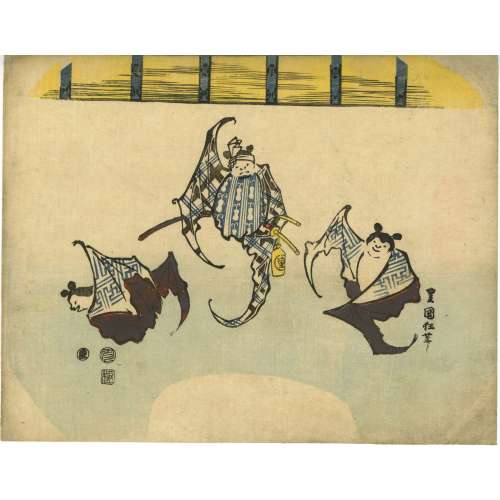 NEWArtist: Utagawa Toyokuni II [歌川豊国二代] a.k.a. Toyoshige [豊重] (Japanese, (1777 – 1835) Signed: 豊国狂筆 (Toyokuni kyō-hitsu, "mad brush of Toyokuni") Publisher: Maru-Jū (丸重), seal Jū (重), Marks reference 08-079 | U190a (1826–1829, only on fan prints) Censor Seal: Kiwame + Bunsei 12 (Year of the Ox [丑], 1829) Media: Uchiwa-e (fan print), color woodblock print, 230 × 293 mm
NEWArtist: Utagawa Toyokuni II [歌川豊国二代] a.k.a. Toyoshige [豊重] (Japanese, (1777 – 1835) Signed: 豊国狂筆 (Toyokuni kyō-hitsu, "mad brush of Toyokuni") Publisher: Maru-Jū (丸重), seal Jū (重), Marks reference 08-079 | U190a (1826–1829, only on fan prints) Censor Seal: Kiwame + Bunsei 12 (Year of the Ox [丑], 1829) Media: Uchiwa-e (fan print), color woodblock print, 230 × 293 mmA fantastical kabuki-themed scene depicting three anthropomorphic bats, dressed in Edo-period costumes. The central figure, likely Ichikawa Danjūrō VII (市川團十郎七, 1791–1859), is distinguished by his costume featuring a gourd motif (瓢箪, hyōtan)—a symbol closely linked to the Ichikawa family. He wears two swords, further identifying him as a kabuki hero, and carries a sake flask marked with what appears to be the publisher's emblem. His raised arm (or wing?) suggests a dramatic action, possibly striking or threatening the bat figure on the left, who recoils in response.
The two side bats, also dressed in patterned kimono, display expressions contrasting with the central figure—one appearing startled, while the other remains cheerful. The oxidized lead-orange pigment used in the lower portions of their wings suggests depth and texture.
This print reflects Danjūrō VII’s association with both the bat (蝙蝠, kōmori) and the double gourd. Bats were considered lucky symbols due to their resemblance to the character of "good fortune" (福, fuku), and Danjūrō VII often incorporated bat motifs into his stage costumes. The Ichikawa family's crest, the mimasu (三升, "three squares"), was more commonly used, but the double gourd and bat imagery appeared in promotional materials, reinforcing his theatrical identity.



